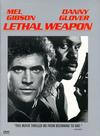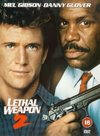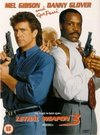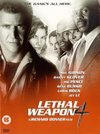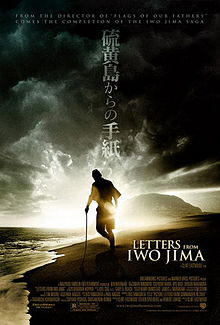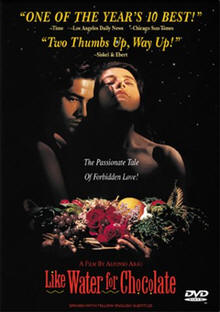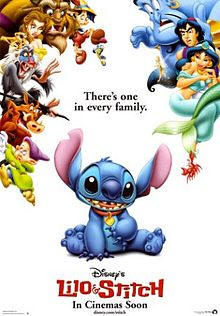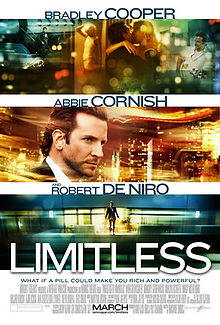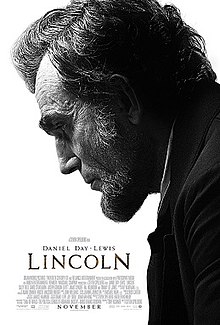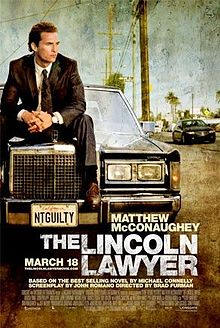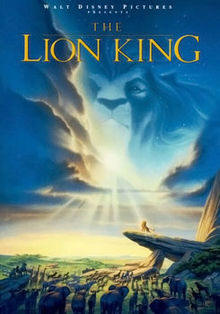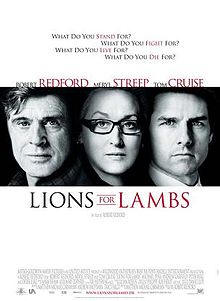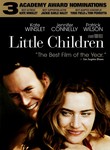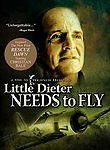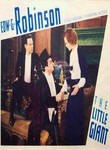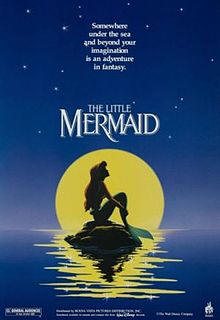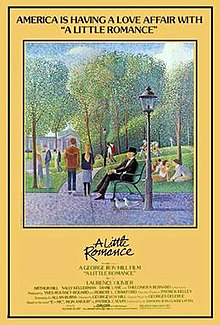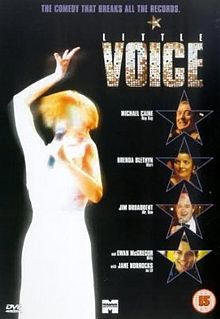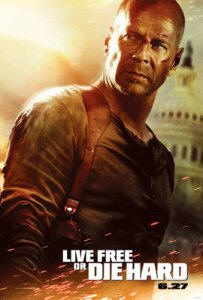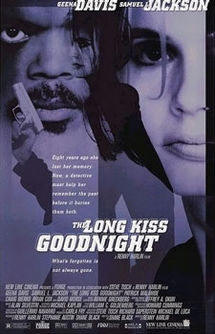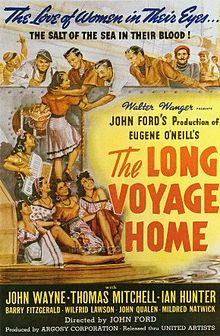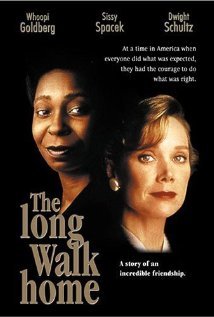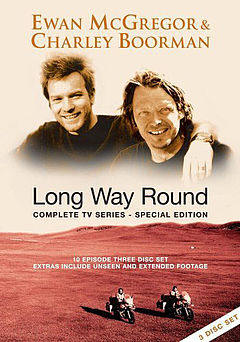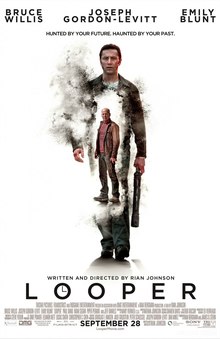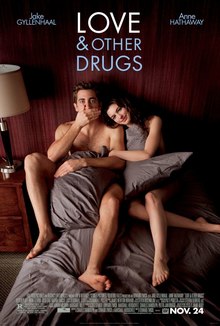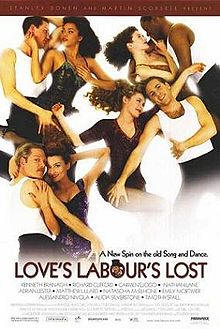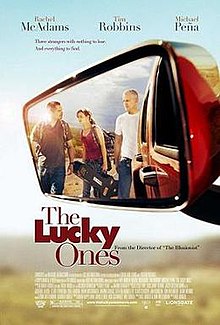|
Movies we've seen © 2004-2013 by John Varley; all rights reserved |
L
|
L.A. Confidential (1997 ... was the year that overblown behemoth Titanic rolled over all the competition at the Oscars. (This is the movie that should have won.) Noir is the word that keeps coming up in reviews, and in my own mind, when thinking about this movie. It's time people stop insisting that film noir must be in black and white, even though noir is black. This is as noir as it gets, and it is gloriously colorful. Visually, it ranks up there with The Godfather and Chinatown in terms of getting the period feel right. In content, it draws heavily on the Los Angeles of Raymond Chandler. We loved it the first time, and we rented it again because shortly after we moved into this Hollywood apartment we became aware that our street was in the film. Get the DVD, go to scene 6. Danny DeVito emerges from some shrubbery and hurries down a driveway to the street. Today, if you walk up that driveway to the end and then turn left, you will be in the parking lot of the building next door to us. Keep going a few feet and you'll probably find our car, parked in the second spot to the north. The house Danny has been snooping on is two doors down from us! As the camera follows him we see, at the end of the street, a brightly lit building with a tower and a theater marquee. A huge sign announces the premiere of When Worlds Collide. That building isn't, and never was, a theater. The marquee is phony. It's still there, empty, and we haven't been able to determine what it was originally. But we use that tower like a bookmark when we're driving down Hollywood Boulevard. That's where we turn to get to our place. Neat, huh? And remember, this is all off the record, on the Q.T., and very hush-hush! IMDb.com L.A. Story (1991) Steve Martin’s own wacky brand of magical realism, and a love note to the wonderful oddness of Los Angeles. It shifts quickly from outright farce to satire to an amazing sweetness without ever setting a foot wrong, which is quite a dance to do. When he’s on his game (and he hasn’t been, for too many years) Steve Martin is the best comic there is, and he wrote and stars in this one. I sure as hell wish he’d make more like this, and stop with the friggin’ Pink Panther, The Out-of-Towners, and Cheaper By the Dozen remakes, and crap like Bringing Down the House. What I need is another Dirty Rotten Scoundrels, or Leap of Faith, or HouseSitter …IMDb.com L4yer Cake (2004) A stylish, sometimes funny flick about drug dealers and a deal gone wrong. But after a while we were both wishing for American subtitles. I’m usually pretty good with Brit accents, but I know a missed a lot of dialogue. By the end, I was far from sure just what was happening, and the final shot, literally, was not needed and felt like a cheat from back in the days of the Hays Office, when the bad had to be punished in the last reel. IMDb.com La Ceremonie (1995) A fascinating film from Claude Chabrol, sometimes called the French Alfred Hitchcock. A disturbed young woman (Sandrine Bonnaire) meets a flat-out crazy one (the wonderful Isabelle Huppert), with disastrous results. The build-up is very slow, and the pay-off shocking. Jacqueline Bisset is in it, and she’s very good. I hadn’t seen her in a while, and she’s aging well. Apparently she’s been working right along, but not in movies that I’ve seen. IMDb.com La Dolce Vita (1960) Recently restored and released on DVD. It had been quite a few years since I’d seen it, so we rented it ... and pretty soon I realized that I had never seen it. I’ve seen just about all the “classics,” the great films, but there are gaps here and there. I hadn’t realized it was so long, almost 3 hours. It is gorgeous to look at. I think Fellini had a black and white heart. The shadows and lighting are awesome. I’ve liked or loved all his earlier films in B&W, didn’t care for most of the color ones. To me, this one has dated a bit. I know it was revolutionary and shocking in its time, nobody but Ingmar Bergman and a few French new wave directors like Alain Resnais were making films like this at the time. But there have been plenty since. It is pretty much a series of episodes that don’t lead to much: rich people leading empty lives and the meaningless journalists who cover them, the cult of celebrity which was just getting started. The word “paparazzi” (sparrow, in Italian) for twittering, predatory flocks of those who flatter themselves as “photojournalists.” It was Marcello’s nickname for his photographer buddy, and the name caught on. It is full of Fellini’s usual trademark symbols, religious and circus and show biz. It is just terrific to look at and I was never bored, but I much prefer his earthier works like Nights of Cabiria and Variety Lights, or for a work of existential ambiguity, 8 1/2. 8 1/2 has one of my favorite movie lines: “I really have nothing to say, but I want to say it just the same.” IMDb.com La vie en rose (2007) In ‘60s rock there were The Beatles, and there was everybody else. In 20th century male popular singers, there was Sinatra, and there was everybody else. But with female singers of the last century, we got very, very lucky. There was Garland, there was Holiday, there is Streisand, there is Franklin, and there was Piaf. I couldn’t really rank them, though I suppose Piaf would be my personal least favorite, merely because I don’t know her genre that well and don’t quite have the ear for it. It’s partly a French thing. But that doesn’t detract from her right to a place with those others in any way. Abandoned by her mother and then her father, raised in a whorehouse and then in the circus, then performing on the streets. Blinded as a child, then recovered or healed, depending on what mythology you prefer to believe. Heavy drinker, morphine addict. No less than three bad car accidents. The love of her life who died in a plane crash as he was on his way to see her. Dead at the age of 47 from liver cancer. Wow! She must have been the luckiest woman who ever lived. I’m surprised she was never abducted by aliens. I mean, could you write a better recipe for a tragedy, and a great singer? Would you exchange longevity for a life lived at that level, for a chance at greatness? I think I would. Some artists would kill for a biography like that. The title is from her signature song, and it means “Life in pink.” The French title was La Môme, which means “The Kid.” I like that title, but am not sure what it refers to, except that she was 4’8”, hence the stage name Piaf, “sparrow.” In fact, unless you are a Piaf scholar, there will be a lot of things you will be unsure of when you watch this movie. It jumps around from her childhood to her deathbed without apparent logic. At the end, I decided the idea was that these were the jumbled memories of a woman whose mind was failing. That’s okay with me; a biopic is very hard to make well, and often thankless because we’ve seen so many of them and just about every way of telling them has become clichéd. There is just no way to squeeze a whole, full life into 2 hours and 20 minutes. Abbreviation is necessary, but painful. And after all, if you want a history lesson you can read a book. A movie should give impressions, and they don’t have to be just the high and low points, but those points that best illuminate the character. Still, sometimes you wish … I mean, we skip from 1940 to 1947. Wasn’t there a little thing called World War Two in there? At one point we see a man who she refers to her husband (she had three). Where did he come from? And very late in the game we learn about a child. So, like I said, not a straight bio by any means. These are minor carps, though. I liked this film a lot, and I learned a bit. But the chief pleasure here is without question the performance of Marion Cotillard. First there’s the physical appearance. Take a look at her in A Good Year, and compare it with her as Piaf. Not the same woman. Then there’s the height. Cotillard is 5’6”, which nobody would call petite, a full ten inches taller than the Little Sparrow. You hear of actors growing into a role. Cotillard shrunk into this one. She somehow seems to have made herself smaller. (Sure, José Ferrer did it with Toulouse-Lautrec in Moulin Rouge, but he was on his knees.) I’m not quite sure how she did it, either. In long shots she doesn’t look tiny in comparison to others, but somehow my impression is of her as a smaller woman. Partly it is her posture, which always seems to be cringing away from a possible attack. Later, she was prematurely hunched, like a very old woman. But most of all it’s just that she somehow seemed to have played it small. There is Oscar buzz, and you can sure see why. With a biopic about a singer, there is a crucial decision that must be made: Do you let the actor sing, or use tapes of the real singer? When Larry Parks starred in The Jolson Story, the decision was easy. Jolson was still alive, and recorded the sound track. Gary Busey sang and played guitar for Buddy Holly. Diana Ross did a pretty good job of being Billie Holliday in Lady Sings the Blues [totally disagree], without slavishly imitating her. Kevin Spacey sounded very much like Bobby Darin in Beyond the Sea. Joaquin Phoenix and Reese Witherspoon not only sang for Johnny and June Carter Cash in Walk the Line, but learned to play the guitar, too. Jamie Foxx didn’t try to sing Ray Charles (good decision, Jamie) but he did play his own piano! I guess the two questions are, how true-to-life do you want the sound to be, and just how important is the distinctiveness of the voice to the story. If they ever do a biopic of Barbra Streisand, they’d better use her recordings or I won’t go see it. On the other hand, I’ve heard a fair number of Judy Garland impersonators over the years. With this one I think it was a no-brainer. Nobody has ever sounded quite like Piaf, before or since, and the uniqueness of her voice was the chief reason for her fame, so they went with the recordings, and it works very well. IMDb.com Lackawanna Blues (2005) An HBO movie, based on an autobiographical one-man show play. There are at least a dozen high-powered black actors in this, plus Jimmy Smits, all with small parts, all obviously eager to get a chance at a cameo in this sweet little film. But it is dominated, as it must and should be, by S. Epatha Merkerson, from “Law & Order.” She plays a saintly but no-nonsense woman who runs a boarding house for society’s losers. The story is episodic and has no dramatic arc, but hey, it’s real life. Does your life have an arc? Everyone involved is very good. And the film would be worth seeing just for the music. Would you believe Mos Def wailing out on “Caledonia!”? Some hip-hop dudes are good right across the musical spectrum. In fact, during the two big party scenes here ... you see why music and dancing were the most valuable resources of black people while they suffered from institutional racism and ostracism from the larger society. Hell, they didn’t need whitey’s approval to be happy. They made “our own paradise on Earth,” and you really want to join in. IMDb.com Ladder 49 (2004) We had no expectations for this, and pretty much liked it. Predictable, I’ll grant you, and some say it exploited all the dead firemen from 9/11. I prefer to think it honored them. I know I’ve never felt quite the same about firefighters since that horrible day. Ladder 49 is organized as a man reviewing his life, from rookiehood to the day he is trapped in a huge burning building with very little chance of getting away live. But his comrades keep fighting hopeless odds. It is more accurate than any fire movie I’ve ever seen, most of which totally ignore smoke, the better to see the action. Interesting detail: The filming of the big warehouse fire in Baltimore was close to the freeway, and thousands of calls flooded into the fire department, to the point they had to put out emergency bulletins on radio and TV telling people what was going on. I sort of wondered, watching it, how many big-budget action movies will be made in the future with “real” effects this big. They can do the old big challenges of scale-model work, fire and water and smoke, in computers these days ... hell, they can do almost anything. IMDb.com Lady and the Tramp (1955) Saturday Night at the Toons! IMDb.com The Lady Eve (1941) We’re almost at the end of our Preston Sturges festival, only two more films to go. (I’m ignoring the unfortunate movies he made near the end of his career, and focusing only on the string of brilliant gems from 1940 to 1944.) This one is right up there with his best. Henry Fonda is a clueless rich guy, Barbara Stanwyck and Charles Coburn are a father and daughter con team. But she falls in love with him. There’s a hilarious scene where Coburn is trying to take Fonda in a card game, and Stanwyck is trying to thwart her father. Who is the best cheat? And there is a famous seduction scene, almost four minutes long, where the actors barely move, but say volumes. IMDb.com The Lady From Shanghai (1947) One of the oddest movies I’ve ever seen, and now an acknowledged classic by Orson Welles. This is in spite the fact that much of what Rita Hayworth says is whispered so quietly I couldn’t hear it with the sound cranked up to eleven, and much of what Welles has to say is in an unintelligible “Irish” accent, and in spite of the plot, which is incomprehensible. Don’t take my word for it. This is from Wikipedia: “When he saw the rushes, [Columbia Pictures President Harry] Cohn detested the picture; he couldn't figure out what it was about and offered $1000 to anyone who could explain it to him. Even Welles could not explain the plot to him.” Of course, it might have been slightly easier to understand before Cohn had an hour cut from the original version. And that’s a tragedy, because even though I don’t really believe Welles’s version would have made much more sense, every frame of this movie is at least interesting, and often brilliant. The composition of shots is amazing. High and low angles, things very close in the foreground, and of course, the literally shattering conclusion in the House of Mirrors in San Francisco’s Playland. Watch how Everett Sloane oozes from mirror to mirror on his canes, or how an extreme close-up of Rita Hayworth is superposed on an angle shot of Welles and Sloane. But even before that the use of light and shadow here is the very essence of film noir. Even the scenes in bright sunlight on the yacht (which belonged to Errol Flynn) seem dark and sinister. Most of the actors give bizarre performances in interesting ways. They all have tics, or insane eyes, or crazy laughs. And nobody could stage a scene like Orson Welles. He was way ahead of Robert Altman in the use of overlapping dialogue, and many scenes are interrupted by little bits of business that have nothing to do with anything, but keep your attention. I have to add that though the courtroom scene was not as wildly impossible as the worst courtroom scene ever filmed (that would be Vincent Price in Leave Her to Heaven), it is pretty laughable. IMDb.com The Lady in the Lake (1947) Raymond Chandler only wrote seven novels. Six of them were made into films, some of them twice. (The only exception, Playback, was pretty bad.) If asked who played the best Philip Marlowe, most people would choose Bogart in The Big Sleep. He was very good, but my personal preference would be Robert Mitchum in Farewell, My Lovely. (Mitchum played him again in a re-make of The Big Sleep, where Marlowe was transplanted to London, which has to rank as one of the stupidest ideas ever to emerge from Hollywood. Some characters are inseparable from their location. You might as well transplant Sherlock Holmes to Los Angeles.) Aside from those two, no one, in my opinion, was a very good Marlowe. Dick Powell in Murder, My Sweet (adapted from Farewell, My Lovely) was pretty bad. James Garner in Marlowe (adapted from The Little Sister) was more like Jim Rockford than Marlowe. Which is not a bad thing, but it ain’t Marlowe. George Montgomery in The Brasher Doubloon (adapted from The High Window) wasn’t within miles of Marlowe. Then we have two movies that very were good despite the fact that the actors were nothing like Marlowe: Robert Altman’s The Long Goodbye where Eliot Gould created a quirky 1970s PI who talked to himself a lot, and this one, where Robert Montgomery really went into unexplored territory. The film is done from the first-person POV; that is, we see everything from Marlowe’s perspective. We see him only when he looks into a mirror. (There are scenes at the beginning and end, and a few in between, where he talks directly to the camera. I think these scenes could have come out entirely, and used as voice-over for more POV shots.) This must have been a novel experience for the actors. Trained never to look at the camera, they spent this entire film doing nothing but looking directly into the camera. This technique presents numerous technical challenges, and I think the cameraman and other technical people solved them all very well. There are two magnificently done sequences. In one, Marlowe slowly explores an empty apartment, finding a corpse in the shower at the end. In the other, he is briefly pursued by a bent cop, forced off the road, the car overturns, and he groggily escapes arrest and crawls to a phone booth. Amazing! There is very little music in the film, but what we do hear is eerie and evocative, abstract, years ahead of its time. The acting is very good, from Lloyd Nolan, Tom Tully, and Jayne Meadows, of all people. She is scary and manic, edgy, nothing I would expect from a woman I know only as a panelist on ‘50s TV game shows, and as the wife of Steve Allen. I would have nominated her for a Supporting Actress Oscar. Then there was Audrey Totter, somebody I’d never heard of, who is pretty much a perfect noir tough girl. Oddly enough, I think actor/director Robert Montgomery was the least interesting of the cast. Let me say again, Montgomery is not Marlowe, and this movie is only fitfully faithful to the book, so Chandler fans, be warned. Montgomery plays him as sarcastic instead of with the restrained cynicism that was in the books. He has too many wise-guy lines, too many tough-guy lines that sound phony. The basic structure of the plot was retained, but a great deal of the details were altered. Big disappointment: we never travel to the lake where the eponymous lady’s body was found. The POV style puts a lot of restrictions on the storytelling, and I know some of the alterations were justified because of this. Most amazing of all, the Audrey Trotter character, Adrienne Fromsett, the female romantic lead, doesn’t appear in the book! And worst of all, Marlowe and Adrienne go off together at the end. Hello? Marlowe doesn’t get the girl! James Bond gets the girl, Travis McGee gets the girl (who then dies). Marlowe does not get the girl. He may fall in love with her, but nothing is done about it. Stupid, sappy, happy ending. So, if you can get through all those changes, or just haven’t read the book and don’t particularly care how Marlowe is played, this is well worth seeing. IMDb.com Lady Vengeance (Chinjeolhan geumjassi) (2005, South Korea) They say revenge is a dish best served cold. Thirteen years is enough time for it to get very chilly indeed. That’s how long Geum-ja Lee (the intoxicatingly beautiful Yeong-ae Lee) has spent in prison for a horrendous crime which she didn’t … or, wait a minute. Did she commit it? It’s not that simple, and neither is anything else in this movie. If you want to find out all the plot details it’s easy enough to do, but you won’t find them here, as I don’t want to spoil the fun of finding them out for yourself. In fact, if you don’t already know the plot, I’d recommend you see this film without learning anything about it … except I will warn you it’s not for the squeamish. The violence is not depicted directly, as in a slasher film, but gruesome things are going on. Suffice it to say that this woman had ample reason to seek revenge, and plenty of time to work out exactly how to do it. The reason I rented this is that we’ve got two revenge movies coming out very close to each other: Kevin Bacon in Death Sentence opened yesterday (to pretty bad reviews) as I write this, and The Brave One with Jodie Foster opens next week. The early buzz on that one is good, as you’d expect from her. I read an interview with her and she mentioned Lady Vengeance, and the reviews were pretty positive. I admit I was expecting something a lot different than what I got. It was directed by Chan-wook Park, who has a cult following among Asian cinema buffs, and is the third of his “Revenge Trilogy.” I haven’t seen the other two. I expected a lot of fighting and a lot of blood, maybe a female Bruce Lee avenging evil. But things aren’t as black and white in Park’s universe. This is a much more nuanced story. And, totally unexpected by me, it had a lot of very funny moments, at least in the first part, in a very dark way. Geum-ja is never quite what she seems. The last part gets so grim it is hard to watch in places. Some crimes are so awful you can barely stand to see them depicted, even in an indirect way. Again, this guy really needed somebody to take him apart, piece by piece. Remember Death Wish, back in 1974? A very controversial film. Vigilante justice? Tut-tut, can’t have that, can we? I think it was a pretty good litmus test, myself. If you really, really, really felt that Charles Bronson was a monster, that these people he was killing deserved a “fair trial,” well, your credentials as a liberal were impeccable. Me, I’m liberal in many things, and I believe that certain people should be squashed like bugs, anally raped with nail-studded baseball bats, flayed alive, disemboweled, and their graves pissed upon. Fuck the law, fuck the jury, fuck the appeals courts. Does that make me a bad person? I think most of us are like that, every once in a while, in our blackest heart of hearts. (I also think most of us wouldn’t go through with such things.) But isn’t thinking about it almost like the act itself? If I am wrong, if I am severely misjudging my fellow humans, then I apologize to you all, and I guess I am a bad person. But I don’t think I’m that different from you. Having said that, I am aware enough to be pretty sure that such acts would not come without consequences. I don’t know if I could get a good night’s sleep if I ever carried out any of my more violent fantasies against people who so richly deserved it. I hope I never have to find out. But this movie is an unflinching, thoughtful examination of the question. Best of all, the story is told with considerable style and flair. This Park dude has an amazing eye. He’s not quite in Kubrick’s class, but pretty much every shot is beautifully composed and just … right. There are special effects that don’t draw attention to themselves but contribute to the telling of the story. And the story itself is artfully laid out, bounding around in time to the point that it almost becomes confusing, but I was always able to keep up with it. Above all, the story was related with images make me think of Hitchcock, though their styles are very different. What I mean is, nobody was better at telling a story though cutting, camera angles, and the essential artistry of filmmaking than Hitchcock. Park is working in that league. He’s that good. IMDb.com Ladybird, Ladybird (UK, 1994) This was a movie so unpleasant that I can hardly remember anything about it, except an outstanding performance by Crissy Rock. She is a bad mother and social services has taken her four children (by four fathers). They’re right to do so ... but they are so heartless you hate them for it. A tough one to watch. IMDb.com The Ladykillers (1955) I believe this is the only one of the classic Ealing comedies that I hadn’t seen ... and boy, am I glad. By that I mean that if I’d seen this first, before seeing the recent remake by the Coen Brothers, I’d have hated the new one instead of merely finding it mildly annoying. Why do they do these things? What is it that leads even funny, inventive, original guys like Joel and Ethan Coen to remake something that was perfect the first time around? You can’t win, artistically, not even with the great Tom Hanks, who was at his worst in the remake. All you can do is cynically cash in on the vast audience who won’t go see a movie older than two years, who demand the sort of foul language that is permissible these days in lieu of actual wit, and who like their slapstick raw and unfunny. So if you haven’t seen it, rent this one, and leave the new turkey alone. IMDb.com The Ladykillers (2004) Reviewed in Coen Brothers. IMDb.com Lakeview Terrace (2008) Second feature at the drive in with Quarantine. IMDb.com Lana’s Rain (2002) The writer/producer/director of this very low-budget thriller strikes me as a film school Quentin Tarantino wannabe, but he doesn’t have the chops to pull it off. It gets off to a very nice beginning, but squanders it in a lot of bloody foofaraw. The lead, Oxana Orlenko, is quite good. She starts off as a war-torn waif in Bosnia, goes through incredible degradation, and ends up a real stunner. You wouldn’t recognize her. She has a lot of range, unlike her co-stars, who are cartoon villains. I hope to see her again. She could have quite a glamorous career. IMDb.com Land of the Lost (2009) First feature At the Drive In with Drag Me to Hell. IMDb.com Lars and the Real Girl (2008) This is the other first feature movie, written by a woman, to get an Oscar nomination this year. (Nancy Oliver also wrote seven episodes of “Six Feet Under.”) Diablo Cody took home the iron, but Oliver has nothing to be ashamed of. In another year, she might have won. And I think it’s interesting that the two bravest and most unusual original screenplays this year were both by women. Writing is still the easiest of the creative jobs in the industry for females to get into. Women directors are still a very much in the minority. There’s no getting around it, somebody tries to describe this film to you and it sounds … creepy. You try to describe it to somebody else and it sounds creepy. It is not, not even a little bit but here goes … a terminally shy young man of 27 buys a “love doll” and treats it like a real human being. Aw, c’mon, you can’t be serious! Wait, wait, there’s more! The whole town decides to pretend she’s a real girl, too. Now you’ve got to be pulling my leg! This could be an Adam Sandler comedy full of fart jokes, funny attempts to fuck the anatomically-correct “Bianca,” and similar horseshit. I’d lose my lunch. The script never descends to any hint of anything like that, though the funniest scenes are of people reacting to seeing Lars and Bianca for the first time. She is not one of these beach-toy inflatables but a very expensive solid rubber mannequin that Lars keeps in a wheelchair. For any of this to work you have to like Lars, and it’s quite an assignment for Ryan Gosling, who pulls it off perfectly. It also helps to have good actors in all the supporting roles, and each of them score a perfect ten, particularly Patricia Clarkson, who Lee and I adore, as the doctor/psychologist who provides what explanations are needed for this bizarre experiment in loving conspiracy. There are real people who are phobic about females, about being touched, about sex in general. Lars is all of these, but he’s also probably the nicest guy in town. He’s not retarded in any way except emotionally, and Bianca is the way his mind has found to pull himself out of loneliness. The doctor, the sister-in-law, the people in town, and eventually the guilt-ridden brother realize this, and that’s why they play along. Eventually it becomes much more than playing. The user ratings at Metacritic were either 10s or 1s. Not much middle ground. The people who hated it all focused on the unlikelihood of a whole town conspiring together in this insanity … for insanity it is, Lars is clearly delusional, and the doctor points this out. But he’s harmless, and what can it hurt? Could it really happen? I very much doubt it, though small towns are funny, and I’ve heard of some actual happenings that warm the heart … but if you insist on seeing only things that could happen, you may not like this. Some people don’t like Frank Capra films. I adore them, and this is as Capraesque as it gets. It’s a fable, folks. Lighten up. BTW: Watch the extra material on the DVD, in particular the short one about “A Real Actress,” where the actors and director and producer and writer carry on the conspiracy, talking about how it was to work with Bianca, and Gosling sits with her as they both are interviewed. Sweet, and very funny. IMDb.com The Last Angry Man (1959) Most movie stars have only one real part they can play, which is themselves. This is not a bad thing, since what they’re selling is their charisma. But now and then someone shows up in Hollywood who can reinvent himself for every role. Laurence Olivier, Meryl Streep, Dustin Hoffman … I think they are more common now than they were years ago. Paul Muni was one of the first. He could play gangsters or writers or scientists. He prepared extensively, sort of anticipating the Method. He was good at make-up and accents. This was his last film. It’s a rare Hollywood film that deals with poverty and tries to get it right. As a result, there are a lot of black faces in the small parts, and they aren’t servants or Pullman porters. This was the first film for both Billy Dee Williams and Godfrey Cambridge, and one of the first for Cicely Tyson, who I didn’t even recognize as she appears in the very first scene as a woman who has been beaten and is dropped off on a doorstep. We hardly see her face. In this one Muni plays a crotchety old general practitioner who has been treating poor people for little or no money for 40 years or so. An ad man looking for people for a new show discovers him, and wants to build a show around him and his patients, “reality TV” in the Early Years. Younger folks may not know this, but in those days almost all TV shows had only one sponsor: Texaco, GE, Chrysler, etc. So you really had to be careful not to offend the sponsor, in this case a drug company. Naturally, the old doc has some nasty things to say about the useless remedies peddled by these companies. He has plenty other things to say, too. The movie never quite goes where I expected it to, which is good. But the doctor is a little too crotchety, a little too saintly for my tastes. I liked it that the advertising man turns out to be a good person, consistently standing up for the old man in the face of crass commercialism. For its time, I think this movie was probably fairly groundbreaking, but I don’t think it holds up real well. Worth seeing, marginally, mostly for the acting. IMDb.com Last Chance Harvey (2008) Emma Thompson is 50. I hadn’t realized that Dustin Hoffman is 71. He doesn’t look it, I’d have guessed mid-sixties. They are both wonderful actors, and it’s a pleasure to see them working together in a romance. The script is pretty sharp, too, most of the time. I sort of wish it had gone on a little longer, with the growing relationship between the two of them. I’ll give it a marginal recommendation. IMDb.com The Last Detail (1973) Has this ever happened to you? With a very few films (this one and The Caine Mutiny are the only ones that spring to mind, but there were a few others) my memory of them is that they were black and white movies. I’ve pondered this for a long time. It’s barely possible that the first time I saw them was on a B&W TV … but that seems unlikely. It’s been so long since I owned a B&W set. A slightly more plausible explanation is that these films were both about the military, which has a strong association with the classic B&W films of the Big War. That, and the fact that the military is a fundamentally drab setting. Gray ships, olive-drab uniforms, camouflage paint, khaki. Not a riot of color. This one, even more than Caine, is a very drab picture, shot in the wintertime, using a washed-out color palette. And really, the only striking color in Caine was the deep blue sea, which we didn’t see a lot of. Just had to mention that. Jack Nicholson thought this was his best performance. Don’t know if he still thinks that, but at the time he felt he was cheated of an Oscar because the studio had no faith in it, brought it out early in the year. And it’s true, the suits didn’t want to deal with it. It was the language, which was still shocking at the time. Very few sentences don’t contain a “fucker” or a “motherfucker” or two. In fact, the movie was basically shot twice. Once with Robert Towne’s brilliant original dialogue, which he refused to compromise on, and once in a cleaned-up version for the TV market. The ironic thing is that, by the time it was finally released, that sort of language had already become commonplace, that’s how fast the de-Bowdlerization of the movie biz was moving. Randy Quaid plays a total loser who was caught stealing $40 from the polio box, convicted, and sentenced to eight years in the brig. The polio box! Eight years! It was the admiral’s wife’s favorite charity, so they threw the book at him. It turns out he is a compulsive thief, and has other mental issues. But basically, he’s just a big, dumb kid. Shore patrol petty officers Jack and Otis Young get the shit detail to take him to Portsmouth prison, where it’s clear he will go through a living hell. The two lifers take pity on him and try to show him a good time. Nobody can play a man with a hair trigger like Jack Nicholson, as everyone will remember from Five Easy Pieces. He’s got a scene just that good with a racist bartender who foolishly says the law says he has to serve Young (who is black), and Jack damn near kills him. And hardly anybody can play a dumb loser like Randy Quaid … and unfortunately it’s beginning to look as if it’s not acting at all. He’s currently in Canada applying for political asylum, claiming a clandestine group called the “Hollywood star whackers” is out to get him. As if you were still a fucking star, Randy! If he tries to reenter the US, he will be arrested, and Canada really has no use for him, either. Ranged against that sort of acting ability, poor Otis Young has to do his best to get noticed, and I’d say he handles it pretty well. It’s a helluva movie, no kidding. There’s no real plot, it’s just the three of them, by bus and train, hanging in bars, going to some weird Buddhist ceremony, beating up some Marines in a rest room just for the hell of it, then to an apartment in New York where Jack tries all his “smooth” moves on Nancy Allen, who is unimpressed. Of course there is a stop at a whorehouse in Boston where poor Randy squirts all over Carol Kane as soon as she touches him. But he does get laid, and is tender about it, and even fancies the whore sort of liked him. Hold that thought, Randy, it’s gonna have to last you for eight years. The ending is inevitable, and sad, when they get him to the prison. All they can do is walk away from it, bitching about those damn Marines. IMDb.com Last Holiday (2006) This is a remake of a 1950 British film with the same title, starring Alec Guinness in the part Queen Latifah had in the new one. The original screenplay was by J.B. Priestley. I'd really like to see that one, but it's not available on DVD. Lady finds out she's dying, decides to spend all her savings on a last fling, doing the things she's dreamed about. Of course you know she's not really dying. From there it shifts to the "innocent good person among the schemers" plot that goes back at least to Nikolai Gogol, as filmed by Danny Kaye in The Inspector General. Other antecedents are It Should Happen to You with Judy Holliday, and Being There. Hollywood perfected this sort of thing in the ‘30s and if you listen you'd swear the incidental music was lifted intact from a Rock Hudson/Doris Day movie of the '60s, with pizzicato strings punctuating everything, along with lonely little woodwind riffs. It's 100% predictable, but I guess it's an okay example of its type. But I swear, if I see the beginner skiing down the mountainside somehow managing to stay upright while doing tricks an Olympic snowboarder couldn't do and ending up in the village square scene again, not only will I not laugh, I won't even be responsible for my actions. No jury would convict me. IMDb.com The Last King of Scotland (2006) Idi Amin Dada (there is some confusion about his real name, and even his birthdate) styled himself His Excellency President for Life, Field Marshal Al Hadji Doctor Idi Amin, VC, DSO, MC, Lord of All the Beasts of the Earth and Fishes of the Sea, and Conqueror of the British Empire in Africa in General and Uganda in Particular. That he was a thug and a megalomaniac should have been obvious to everyone, but it wasn't, maybe because he was replacing Milton Obote, another of the long and depressing line of thugs and thieves and madmen who have run African countries since the murderous and racist colonial powers departed and left the continent in shambles. Amin didn't look so terribly bad, in context. That he was a psychotic didn't become obvious for some time. As in many other African holocausts, no one knows the exact number of people killed during his regime, but a good estimate is 300,000. (That is fairly close to the number of deaths caused by Monkey Boy, Dickhead Cheney, Cuntaleeza Rice, and "Rummy" Bumfuck. Impeachment, anybody? War crimes trials? Amin escaped all retribution; maybe Monkey Boy and company can be held to account.) The story follows the short career of a young and sort of idealistic and very naive doctor (he seems more bent on adventure than actual humanitarianism, though he does work hard at the Ugandan bush clinic where he lands, pretty much at random) as he stumbles into the role of Amin's closest advisor, something he never asked for but stupidly thinks might be a way to help Uganda. By the time he discovers the horrors of what is going on around him, he's pretty much fucked. Then the movie turns abruptly into a suspense story of whether he can make his escape with his head still on his shoulders. I think a great opportunity was missed here. I know you have to make a story like this personal, it's almost impossible to tell a story of such great events by covering it all like a documentary; leave that to the documentarians. That's why movies like The Killing Fields and Hotel Rwanda work. They tell the story from a limited point of view. The moral question that should have been much more to the forefront is that of the limits of collaboration and how much evil rubs off on you if you abet a mass murderer, even unwittingly. At some point it becomes too late to shout "I didn't know!" At some point, you should have known, if you were paying attention, if you weren't spending your time screwing Idi's third wife. The movie largely sidesteps this question by becoming a thriller. I don't really much care if the doctor escapes, I want to see how he faces the music, and his own crimes of omission. This is worth seeing if only for Forrest Whitaker's Oscar-winning performance. It is a role that he was physically born to play, the resemblance is amazing. But resemblance aside, you have to be able to inhabit the man's madness, and Whitaker does an excellent job. He scares the crap out of you, even when he's smiling. Maybe especially when he's smiling. You can always see the slavering beast just beneath the skin. IMDb.com The Last Man on Earth (1964) I hadn’t been aware that Richard Matheson’s excellent 1954 novel I Am Legend had been made not just twice, but three times, until I saw this listing for the MGM Channel’s “Price of Fear” festival on Halloween night. I had seen Charlton Heston in The Omega Man (awful, just awful) when it was new, and saw the Will Smith re-make (but for some reason, it looks like I didn’t review it), the first to use the original title. (I recall being unimpressed.) As in all three films, they screwed with the original concept and lost the original ironic intent of the book. If you’ve never read it, the idea is that there are two types of plague victims: the zombie-like, brainless bloodsucking vampires, and a second group who have some immunity to the virus and are able to remain quite human, though they avoid sunlight. These people are trying to rebuild civilization, and Our Hero, Neville, has been killing them indiscriminately (well, he didn’t know about the two types). At the end, as he’s about to be executed, he realizes the New Race, the intelligent vampires, see him as the deviant … and they’re right. They fear him. He is the bogeyman vampires used to be. He is legend, or soon will be. Parents will scare their children with tales of the Neville Monster. All three movies missed this, which is really the point of the novel. This movie is the worst of a bad lot. Everything about it stinks. It was shot on a low budget in Italy. It has some of the worst day-for-night scenes since Plan Nine From Outer Space. One minute Vincent Price will be driving along in what looks like broad daylight in an exterior shot, then we see him in his car and it’s night. The vampire-zombies have all night to attack his house, every night for three years, and they have made no headway against his totally pitiful defenses, which include boards nailed haphazardly on his windows, with gaps big enough for a small zombie to crawl through. Okay, they’re dumb, but in three years nobody ever thought of a Molotov cocktail through the window? I could go on and on, but what’s the use? This is a bad, bad film. Avoid it, even if people tell you it’s a classic, unless you get off on bad movies. IMDb.com The Last Picture Show (1971) The dying little town of Anarene, Texas, is not actually Hell, but it’s a pretty good first draft. I’ve never thought of Hell (when I think about it at all, it is only as a mind game; there is no literal Hell) as eternal flames. It’s more like a doctor’s waiting room or the Department of Motor Vehicles where your name never gets called, or like a small town in Texas. I grew up in a small town in Texas. I know. Anarene is actually Archer City, where Larry McMurtry, the author of the book this movie is based on, grew up and still lives, and where this movie was shot. He also co-wrote the screenplay, back before he was well known. (McMurtry now owns and operates a large bookstore in Archer City that I suspect loses money, like Stephen King’s radio station that plays a continuous medley of Steve’s Favorite Rock ‘n Roll … but they can both afford to lose some money. McMurtry runs the bookstore because he loves books. It’s called Booked Up, and you can see it on Google Maps if you navigate down Center Street. Can you believe it? Somebody took the time to drive the two main streets of Archer City for Google maps!) The wind blows most of the time in Archer City. They used to say that between the Texas Panhandle and the North Pole there was nothing but a bob-wire fence, and that was blowed down most of the time. (Archer City isn’t quite in the Panhandle, but it’s close enough.) That’s in the winter. In summer the 110 degree wind blows mostly dust. The “big city” it is closest to is Wichita Falls, about twenty miles away. Fort Worth is about 60 miles down the road. There are hundreds of towns like Archer City in Texas, pretty hard to tell one from another unless you can see a street sign. These used to be thriving communities, each of them with a picture show, but in the early ‘50s television killed pretty much all of them. That meant that all that was left for entertainment in towns like Ararene was football and screwing, usually with somebody else’s wife or husband. Everybody knew everybody and they probably still do. It’s a redneck Lake Wobegon, and Larry McMurtry is the town’s Garrison Keillor. He has affection for these people, but it’s a love/hate relationship. The town is so barren, windswept, hunkered down to the ground. Believe me, your only hope if you were born in such a place is to get out of it as soon as you can. This movie, in glorious black and white, captures the look and feel of places like that so well it almost hurts to look at it. I recently read the fifth (and surely the last) book in McMurtry’s Anarene Saga, Rhino Ranch. It’s not a very good book. But neither was Texasville, the sequel to The Last Picture Show. I didn’t read Book Three, Duane’s Depressed (the title depressed me enough to put it right back on the shelf) nor Book Four, When the Light Goes. I probably shouldn’t generalize, but I think maybe Larry ought to stay away from sequels. None of the three sequels to Lonesome Dove was half as good as the original. He also wrote sequels to Terms of Endearment and The Desert Rose, and neither were nearly as good as the first one. But for both McMurtry and Peter Bogdanovich, this novel and movie got them off to a hell of a start. (This was McMurtry’s third book, and the first was made into the movie Hud, but this was the one that really got his name recognized.) And for that matter, a lot of other people new to the movies got big career boosts: Jeff Bridges, Timothy Bottoms, Randy Quaid, and Cybill Shepherd. It also earned well-deserved supporting Oscars for veterans Cloris Leachman and Ben Johnson. Johnson’s performance was understated and moving. Leachman’s final scene, the last in the movie, is electrifying, stunning, as raw as I’ve ever seen emotion on the screen. And it was done in one take, with no rehearsal, to her considerable shock. She figured she’d have at least one more shot at it, but Bogdanovich said no, that one was fine, and he was right. This movie is a masterpiece, one of the best movies ever made, and Bogdanovich himself admits, in the hour-long DVD retrospective, that he’ll probably never make another movie as good—which ironically makes him much like his good friend and mentor, Orson Welles. Welles did a few good movies later, but never approached Citizen Kane again. Bogdanovich had a hot streak with What’s Up, Doc?, which I’ve always liked, and Paper Moon, but then faltered badly with Daisy Miller, where he tried to make his girlfriend, Cybill Shepherd, into more of an actress than she really was, and the disastrous At Long Last Love, where he somehow thought casting non-singing, non-dancing movie stars like Burt Reynolds in a song-and-dance musical—and letting them do all their own singing and dancing!—was a good idea. He never really recovered from that. But The Last Picture Show remains as his lasting monument. You make one picture like that, and you don’t really have to do another good one to go down in cinema history. Personal footnote: After decades of playing cowboys in B-movie shoot-‘em-ups, Ben Johnson was not sure he could handle the role of Ben the Lion, a real cowboy. He had to be talked into it. Meanwhile, Bogdanovich was toying with the idea of casting another unknown, John Ritter, as Sonny. If he did, he thought if he couldn’t get Ben Johnson it might be fun to cast another old cowboy star as Sam: Tex Ritter. This was the bargain basement singing cowboy, the one who was in the movies that were too dumb for Roy Rogers and Gene Autry. And ol’ Tex was from … drum roll … my little Texas town, Nederland. Well, he wasn’t born there, and he went to school in nearby Beaumont, but his family owned the Ritter Hardware store in Nederland, which is still in business. IMDb.com The Last Samurai (2003) God, I hope so. IMDb.com The Last Shot (2004) An FBI sting involves pretending to make a movie (this apparently actually happened). Matthew Broderick is the director, totally in the dark, Alec Baldwin is the FBI producer, who is gradually seduced, as everyone who has ever touched the movie business is, into actually wanting to make this turkey. The cast is to die for, especially Toni Collette, the situation is funny, there are a lot of funny lines ... and yet it doesn’t quite come together. I kept feeling I should be getting more laughs. What it does best is to capture the giddy feeling of mixed joy and tension and full-focus dedication as a movie is developed and then actually goes before the cameras. As Roger Ebert said in his review, “Nobody ever sets out to make a bad movie.” This is true, I can vouch for it. Even the people working on a piece of shit like Alien vs. Predator or Taxi or Millennium have a vision. It may not be Kurosawa’s or Bergman’s vision, they may only be seeking to entertain you, but they want to do the best they can. IMDb.com Last Train Home (Canada, China, UK, 2009) Wiki says the population of China is 1,339,724,852. Over a billion of them don’t travel for the New Year’s holiday, but about 130,000,000 of them do. All at once. It is the biggest migration of humans anywhere on the planet, much bigger than the Hadj, bigger than the mind-boggling gatherings of millions on the banks of the Ganges. Most of them are returning to their villages from their mind-numbing jobs in the cities, and most of them go by train. The train system in China is not nearly up to the task. This amazing and heartbreaking documentary follows one couple over two years, with two trips home to see their daughter who, all her life, has seen them only a few days a year. The hardships to get there will make you weep. If you’ve ever waited overnight in a crowded bus station … you don’t have the faintest idea of what these people go through. They wait for days, standing up, in the rain, shoulder-to-shoulder with the other millions, trying to bribe someone by paying three times the normal ticket price. They live in a dormitory with no walls, work all day sewing jeans for you and me, all of this so their children can get an education and live a better life. And what is the result? Their daughter doesn’t want any part of it. She doesn’t know these people, doesn’t love them. The standard story of the dutiful Chinese child breaks down here. All she wants to do is get out of her beautiful little town—where there is no work—and go to the same shithole city where Mom and Dad work, get a job sewing, and go to nightclubs (where she serves drinks), talk on her cell phone, and buy some nice clothes. It is so, so sad to see what is really behind the Chinese “economic miracle,” and you have to wonder what’s going to happen if and when The People finally get fed up with it. A communist revolution? Could happen, because what they have now, with billionaires and a growing upper class, and a billion with almost nothing, sure ain’t what Mao had in mind. IMDb.com Late Marriage (Hatuna Meuheret) (Israel, 2001) At some point watching this, Lee said something like “This is the anti-My Big Fat Greek Wedding.” She’s right. In that one, ethnic families were a jolly thing to be endured. It was funny, trying to live with old-country values in modern America. This movie is in an ethnic Georgian community in Israel, and these Georgians don’t fuck around. A 31-year-old man, still being supported by his family, is enduring an endless round of bride interviews. We see one, and it is horrific, part yard sale and part slave auction, with both families trying to sell the prospective bride and groom. Trouble is, the guy is seeing a 34-year-old divorcee with a young daughter. Absolutely not! The family visits her, with the son present, calls her a whore, threatens to kill her. And you believe they would. And the guy takes it. At the end, he’s marrying some stranger, drunk out of his mind. He actually tries to kiss his father’s balls ... apparently because he has none of his own. My own prejudices are unavoidable here. I know that romantic love affairs often (hell, even usually, these days) produce disastrous marriages. But it never occurred to me, not once in my life, to do anything my family told me to after I was 18. (Luckily, they never tried; I’m not from that sort of ethnic background.) So I know what I would have done. And, from my point of view, this man is a coward. The big question for me is, does the man have no spine because his family systematically castrated him over 31 years, or was he simply born with no balls? You decide. I must mention that this film contains one of the most realistic sex scenes I’ve ever seen in a movie, and I emphatically include hardcore movies, where the sex is by the numbers, almost never convincing. I’m not talking about graphic, explicit shots, though there is nudity. This scene is extended, and brutally and comically honest. It’s real, like you’re actually peering into someone else’s bedroom, and discomforting because of that, but in the end it’s well worth watching unless you’re prudish. IMDb.com A Late Quartet (2012) The Fugue string quartet has been performing together for 25 years, and consists of First Violin (Mark Ivanir, a Ukrainian-Israeli with a lot of supporting film credits), Second Violin (Philip Seymour Hoffman), Viola (Catherine Keener) and Cello (Christopher Walken). Cello is the heart of the ensemble, the oldest of them, the man that keeps them all together and on the straight and narrow. Viola and Second are married, and have an aspiring Solo Violin daughter (Imogen Poots, and have you given any thought to changing that name, darling?). But Cello is diagnosed with Parkinson’s and will soon have to retire. This revelation serves as the catalyst for bringing a lot of buried issues to the surface. Viola thinks it might be best if they just pack it all in, unable to imagine carrying on without the stable center that Cello provides. Cello is having none of it, and insists he can be replaced by Nina (Nina Lee, who puts in a brief appearance at the end, and is a real cellist with the Brentano Quartet, who played all the real music here). He negotiates with Wallace Shawn, whose trio Nina is currently playing with, and is rebuffed. Meanwhile, First begins an affair with the much younger Solo, which greatly upsets Viola and completely stuns Second. Cello tells First he must give her up, which he refuses to do. But Solo has a big surprise for him … which I won’t get into. And Solo has her own issues with Viola, over lack of parenting while Viola was out of town for seven months of the year. And then Second makes a big mistake by having a one-nighter with Flamenco Dancer (Flamenco Dancer? Where does she fit into the quartet?) and Viola throws him out … Bit of a soap opera, right? Still, in the hands of these actors and with an intelligent script, it all works very well. But the biggest issue, to my mind, and the reason I’ve been referring to these people by their instruments, is the one that is unique to a tight-knit musical groups like this, which is Second’s simmering resentment at First and the others for being second chair all these years. And at First for being such a controlling person, not letting them break out and explore, as Second believes they should be doing. I thought about this a lot. Where I’m coming from is the perpetual second-chair French horn in my high school band. Three years of sitting beside my friend Phil Richie and listening to him do all the solo bits. And believe me, I was fine with it. I did not have the musical drive to practice more, I didn’t want the first chair, didn’t want to stick out doing the solo bits. I was happy. But not Philip Hoffman. To these people, music is their life. Everything else takes a back seat (or maybe second chair), including family. And Second may believe he is as good a fiddle player as First is, maybe even better … but to my mind, that’s not the most important thing. For a certain sort of person, being the leader is a must. They can’t sit in the second chair. They must be either a soloist, or the first chair. Walken may be the spiritual center of the group, but Ivanir is the musical leader. Just look at a major symphony orchestra. There is a vast gulf between the first violin, known as the concertmaster, and the second chair. And, for that matter, all the other massed violin players. You know all those others are very good with their axe or they wouldn’t be playing with the philharmonic, but only one makes concertmaster. In my opinion, he (it is almost always a man) is the one who has just that little bit more drive, ambition, dedication. Skill? Yes, but that’s not the only thing. If Second had had what it takes to be First, he wouldn’t have planted his butt in that second chair for twenty-five years, no matter what other excuses he comes up with for his situation. My opinion, anyway. The performances here are all just terrific. It is wonderful, in particular, to see Chris Walken playing something other than a psychopath or other very weird character. Here he is calm and controlled, very human, the best in a lot of stand-out performances. Now, I’m not saying I want him to stop playing psychopaths, he’s one of the best psychopaths the cinema has ever seen. But it’s nice to see him essay something very different, just as it is always a hoot to see him dance. And for once, the ending was satisfying. I’m very leery of emotional final scenes with a dramatic announcement on stage, but this one moved me. Walken handles it with grace and dignity, and so do all the rest. And so the old falls by the wayside, to make room for the new talent … Bittersweet, but life, and music, goes on. IMDb.com The Late Show (1977) Robert Benton doesn’t have a lot of screen credits, but they’re mostly good ones. He’s won three Oscars, for writing and directing Kramer vs. Kramer, and for writing Places in the Heart. He also wrote Bonnie and Clyde. He hails from Waxahatchie, Texas, a place in my heart, a little town my family drove through hundreds of times on our way to visit my grandparents in Corsicana, 35 miles down the road. (Also the home of the world’s most expensive hole in the ground, the never-to-be-finished Superconducting Super Collider, canceled by Congress in its wisdom in 1993 after 2 billion dollars had already been spent.) For my money this movie could easily have been his 4th and 5th Oscar, except that was the year of the fabulous Annie Hall. Whatever, it’s still one of my favorite movies, ever. Art Carney is Ira Wells, a sick, gimpy, hard-of-hearing, retired PI taken right out of ‘40s pulp fiction and landed uncomfortably in ‘70s Hollywood. Seriously flaky Margo Sperling (Lily Tomlin, who he always calls “Doll”) hires him to find her kidnapped cat. You will suspect that Ira is ten times smarter than any of the mopes he comes up against, and you will be right. You will suspect that Ira and Margo will come to like each other a lot, and you will be right. None of that detracts in the least from the delights of this movie. Art Carney is absolutely brilliant in the greatest performance of his life (even better than the one he got the Oscar for in Harry and Tonto), and Lily is … well, Lily. When was the last time you saw a hard-boiled detective taking the bus to confront the bad guys, or doubled over in agony from a perforated ulcer? Everything about this movie is just right, very much including supporting roles by Bill Macy and even more by Eugene Roche, as a fence who can’t resist trying to pay for everything with an Amana microwave, or a new Cadillac, your choice of color. Dude should have had a Supporting Actor nomination. IMDb.com Laurel and Hardy Two-reelers. In the 1950s in my hometown of Nederland, Texas, we came home from school to sit down and watch ancient Z-grade westerns with Ken Maynard and Hoot Gibson, and Our Gang comedies. The third leg of this public domain afternoon trilogy, and the best, was Laurel & Hardy two-reelers. How we loved this mismatched set of goofs! A few days ago TMC had a full day of L&H shorts, and I TiVoed ten of them. They are still as good as they ever were. Thicker Than Water (1935) The henpecked husband was a frequent theme. And why not? Big as Ollie was, he had no real violence in him. For all his bluster he could be bossed around by anyone in the world except poor clueless Stanley, so it makes perfect sense that his wife, about a third his size, terrifies him. Here he has lost the money that should have gone for rent, and has to find a scheme to get it back. There is a lovely bit of business whereby, when he is leaving a scene, he reaches up and grabs something at the edge of the frame and pulls a ‘wipe” across the screen, with the next scene already playing on it. (We don’t see wipes much these days. Here’s is how they go.) Later, Stanley tries the same thing, loses his grip and the next scene rolls back like a window shade rolling up. He has to go back and grab it again. I loved it. IMDb.com Tit For Tat (1935) The title could sum up some of the very best bits L&H ever did. You know how it goes. Somebody does something nasty to somebody else: Dumps a bucket of water or paint over his head, pours molasses over him, makes him sit down on a crate of eggs, stuffs something awful down his pants. The offended guy retaliates. Then comically increasing retaliation. All through these indignities the offended party just stands there and takes it, blood boiling, then takes his revenge. There is no reason in the world why anyone would just stand there and take it … except that it’s funny that way, and that’s reason enough. This time its with an angry grocer next to the electrical appliance shop the boys have just opened, and it’s a classic. IMDb.com Towed in a Hole (1932) They run a business selling fresh fish. They decide to buy a boat and catch their own fish. It has a few leaks, so naturally they fill it with water, and naturally Ollie gets soaked in every way it is possible to get soaked. Then they can’t get it moving, so they put up the sail …and car, trailer, and boat are demolished. IMDb.com Them Thar Hills (1934) Ollie has gout. Well, serves you right, you bonehead, for eating all that rich food! says Dr. Billie Gilbert. He advises a rest cure in the mountains, drinking plenty of water. What they don’t know as they pull up in their ‘30s RV (a box like a large packing crate on wheels) is that a bunch of moonshiners have dumped their hooch in the well. They get jolly drunk and are joined by their standard nemesis, a short, choleric, mean-spirited little man. Soon they are engaged in a very good “Tit for Tat” battle (see above). A really great one. Ollie was one of the all-time great laughers. IMDb.com The Live Ghost (1934) A captain hires them to Shanghai sailors. They end up being the last ones Shanghaied, and have to avoid the crew’s vengeance. They think they have killed the drunken first mate, who falls into a vat of white paint and comes back to haunt them. Not one of their very best. IMDb.com Beau Hunks (1931) The opening credits list 3,897 Arabs, 1,944 Riffians, and 4 Native Swede Guilders. It’s a take-off on Beau Geste, with Ollie going into the French Foreign Legion to forget a failed romance. (Turns out every man in the army is mooning over the same picture he is; it’s Jean Harlow.) At 37 minutes it’s neither a short nor a feature. Apparently they liked it so much they just kept expanding it. There’s a pretty high budget here, before they began making real feature films. IMDb.com Going Bye-Bye! (1934) The boys have testified against a violent, angry hoodlum and he is going to jail, but vows to get them, tear off their legs, and twist them around their heads. They decide to leave town, but somehow end up with the escaped hood packed in a trunk. They try to get him out, not knowing who he is, and almost manage to kill him. Naturally they end up sitting on a couch with their legs tied around their heads. IMDb.com The Hoose-Gow (1929) Here’s one made on the cheap. There’s a minimal prison set, and the rest takes place on a road gang. The extended bit: Ollie drives a pickax through the radiator of the visiting governor’s car. To plug the leak they fill it with rice. The rice boils out, and soon everyone in sight is playing tit for tat with handfuls of boiled rice, seldom hitting what they are aiming at. Good one. IMDb.com Dirty Work (1933) Just as you know that if L&H get a job whitewashing a fence they are going to end up white from head to toe, you know that when they become chimney sweeps they will be black. Lots of good gags, culminating in a mad scientist who invents a rejuvenating formula that turns a duck into an egg and Ollie into a chimp. IMDb.com Oliver the Eighth (1934) Stan and Ollie both plan to marry a rich widow, not knowing the reason she wants to have Ollie in her house is that she has declared war on Olivers because it was an Oliver who broke her heart. She has killed seven Olivers, in cahoots with her mad butler who plays cards with an invisible deck. It’s a hoot, except for the cop-out ending that it was all a bad dream. Ran out if ideas, I guess. IMDb.com Laurel Canyon (2002) Has Frances McDormand ever been bad in a film? I sure can’t remember one. I’m so glad she got her Oscar for Fargo, because she doesn’t have the glamour to be a leading lady except in quirky roles like that. This was a good film, three stars or so. IMDb.com Law Abiding Citizen (2009) Second feature At the Drive In with Paranormal Activity. IMDb.com Le cercle rouge (1970, French) A hugely influential movie from Jean-Pierre Melville, a French director who never made a big name for himself in America. Though it's in color, this is the sort of movie that the term film noir was invented for. Nobody in it is very nice, but man, are they ever cool! Many directors of American thrillers count Melville as one of their heroes. The cast is great, with Alain Delon, Bourvil, and Yves Montand, who may be the coolest actor ever to appear in film. That world-weary, hound-dog face ... That said, it's not a very emotionally involving movie. It's more of a lesson in cinema construction, complete with archaic devices like wipes and some imaginative editing in the violent scenes. The centerpiece is a really nice jewelry heist, worth the price of admission all by itself, right up there with Topkapi, Rififi, and The Hot Rock. IMDb.com Le Havre (Finland/France/Germany, 2011) This film is odd in many ways, not least of which is that it is set in the French port city of Le Havre, is in French, but it was written and directed by someone I at first thought was Japanese. His name is Aki Kaurismäki, and doesn’t that look Japanese? But I didn’t spot the umlaut at first. It turns out he is Finnish! He has a following a bit too large to call him a cult director, but his films are all quirky and not likely to make a lot of money, at least in America. I hope he’s better appreciated elsewhere. We saw one of his films, The Man Without a Past, and loved it. I’d like to see more. (This film reminds me strongly of another we saw not too long ago, and whose name I can’t seem to recall. In that one, a hopeful young boy from the Middle East somewhere wants to get to England to reunite with his true love, who is about to be forced into marriage with some rich swine, but he is stuck in France. He decides to swim to England. One little problem: he can’t swim. He is befriended by a swimming teacher and other sympathizers rebelling against the French immigration police, who are portrayed as little different from the Gestapo. He gets fairly good at swimming, sets out … and drowns. Not what I expected! Can anyone help me out with the title?) Here the boy is from Gabon, and has spent three weeks in a cargo container that has become misplaced at the bottom of a huge stack of them. When it is opened the people inside are all right (whew! I was ready for disaster), and as they are taken into custody Idrissa escapes. Again, the French police don’t look so damn good. One Fascist cochon is about to machine gun the boy! He is befriended by an elderly man and most of his neighbors, and eventually put on a boat to England. Which doesn’t sound like much, but it’s a lot more in the telling and the deadpan acting. It looks great, and makes you feel good without getting all mushy for a second. The high point is a benefit concert to raise money to pay the smuggler. It is the return of “Little Bob,” an elderly singer who is probably of my generation. He really rocks it in his red leather jacket and snow-white Elvis hair. Lee and I loved him. He had the feel of a “real” person, not a character, and when we looked him up later we found that he is. He’s the sort of person that, if you grew up in France, you would know as well as we know Chuck Berry or Bill Haley. His only competition in French Rock fame is probably Johnny Hallyday, who we saw a long time ago in a movie called The Man on the Train. IMDb.com The League of Gentlemen (UK, 1960) As I probably say before the review of any movie about a caper or a con game (I’m not going to check them all) I love movies about capers and con games. I find that most of them are labors of love, too. Someone has a clever story to tell, and wants to tell it as fairly as possible, setting it up, starting the caper, and then pulling a reverse or two on your unsuspecting ass. True, there are dishonest ones, and ones that didn’t quite make it to where they intended to go, and a few actual turkeys. But mostly, they are good. This is a great one. Jack Hawkins is an ex-Colonel who feels he was short-changed for 30 years of service by a niggardly pension. He assembles a crew of seven ex-soldiers, every one of them a fuck-up in civilian life, most cashiered from the army for one transgression or another, but every one of them very good in his particular field. Jack has read a book that outlines a bank robbery that he thinks just might work, with some refinements … … and I must digress a moment here to mention that the great Donald E. Westlake, 22 years later, wrote a similar story: Jimmy the Kid. (Great book, from which they made a pretty bad movie.) In it, his motley crew led by John Dortmunder pull off a kidnapping, following the plot of a book one of them has read, called Child Heist, by Richard Stark. I don’t know if Westlake ever saw this movie, but either way, they are hardly similar at all other than that detail. A great inside joke is that Richard Stark is Westlake, he wrote about 20 hard crime books under that name, though he never wrote Child Heist. Back to the movie … … The best caper movies start by assembling the cast, as this one does. We get to know a bit about them, and what sort of hold Jack has on each one. They all agree to be in on it. Jack’s idea is that they will plan and execute the robbery as a military operation, complete with officers and a barracks in his big house, and fines for disobeying orders. Another thing this does right is to show some of the planning. First they must pull off a robbery of an army depot to get the guns and other equipment they need. They do this as a Big Con, using guile and impersonation, and it’s flawless. Then … You can’t say much about the end of a caper movie without spoiling the fun of it, but I will issue a minor SPOILER WARNING here, though I don’t really think it’s necessary. These stories almost never end with the robbers getting away clean, do they? Very seldom. So you go in expecting they will be caught. The fun is trying to spot what will go wrong. It’s usually a tiny detail, as in one of the best, Topkapi, where a little bird foils the grand plan. All I will say is that the fuck-up here is something that could never have been believable in the US. It could only have happened in a country where legions of people are engaged in the ridiculous practice of “trainspotting,” where they try to collect the serial numbers of every locomotive in the UK. Doesn’t that sound like fun? Me, neither, but they do it. IMDb.com A League of Their Own (1992) World War Two was a good time for the Negro Leagues of American baseball. Most of the white stars were in the military (where I believe a lot of them battled Hitler and Tojo by playing ball), so MLB was a shadow of its former self. Black men were drafted, too, but at home many black people had good-paying jobs for the first time in their lives, working in war industries. They had money to spend, and they packed the ball fields. It was also pretty much the first time women were able to make any money at a team sport, in the All-American Girls Professional Baseball League, founded by Philip K. Wrigley, the chewing-gum magnate and owner of the Chicago Cubs. They played from 1943 to 1954, and in their best year they pulled in almost a million dollars at the gate. At first there were only four teams: the Kenosha Comets, the Racine Belles, the Rockford Peaches, and the South Bend Blue Sox. Eventually there were eleven teams and, like the All-American Boys Professional Baseball Leagues (also known as the Major League) those teams often hopped from city to city at the whim of the owners. They even had a song:
Okay, it’s not “Take Me Out to the Ball Game,” but it’ll do. This movie is obviously a labor of love on the part of the director, Penny Marshall. The last twenty minutes or so is devoted to a reunion of some of these tough old babes at Cooperstown, where a room is being dedicated to the AAGPBL. We see some of the actual veterans batting the ball around. It has little to do with the movie, but who cares? It’s moving. These women were far ahead of their time. Women’s team sports will probably never make the kind of money that men’s leagues do, but girls these days have so much more opportunity to experience sports. The AAGPBL girls had to wear skirts to play, take lessons in etiquette and deportment, and had to wear lipstick at all times. There were many other indignities. Well, that’s the way we react to it all, and so do the actresses in the movie, though it’s not clear to me that the actual women saw it all as degrading as we do. It was a different time. I suspect most women wanted to wear lipstick at all times. All the cast is good, particularly Rosie O’Donnell before she became a big celebrity. The sub-plot of Geena Davis and little sister Lori Petty with an inferiority complex struck me as a little lame, but the other stuff about the trials and travails of making it all work before a skeptical public worked for me. But the star turn is Tom Hanks as a washed-up alcoholic manager who is so divorced from the team that he doesn’t even know their names. And he doesn’t have a Come to Jesus moment when he suddenly reforms, cuts out the booze, and begins to love everybody. He gets interested because he finally notices that these girls are playing some damn fine baseball, and baseball is the only thing he’s ever loved, aside from the bottle. From that moment, he can’t help being engaged, wanting to win. It’s in his blood. And he has one of the all-time classic lines. He’s savagely chewed out a player who can never seem to remember to throw to the cut-off. She starts to cry. Tom looks at her incredulously, and hollers, “There’s no crying in baseball!” I did a little research, and have to report an historical inaccuracy. The game these girls played was actually more like softball, at least at first. The mound was real close to the plate, they had to pitch underhand, and the ball was the size of a softball. But you know what? Sometimes historical accuracy gets in the way of a good story. By the time the league folded they were playing actual baseball, and while I have nothing against softball (in fact, I think the International Olympic Committee should be taken out and shot for eliminating it from the London Games), it’s just more exciting to see someone, male or female, take the traditional wind-up and fire it over the plate. IMDb.com Leap of Faith (1992) Steve Martin used to be one of my favorite comics, and he still can be, if he tries. Trouble is, he hasn’t been trying much lately. From his first film right up to this one, he had an amazing string of critical and financial successes. After this one, his career just seems to peter out, though I guess he’s still making money. This is one of his best. It isn’t a comedy, though there are plenty of laughs watching him capering around on stage as a big-time, high-tech tent revival preacher and con man. Watching him, you might think he’s way over the top, but I tell you, brothers and sisters, he’s not. I’ve seen a meeting like this, and there is literally no trick these guys won’t stoop to. They could sell shit in a sewer, and make you think you got a bargain. Every born-again Christian ought to see this, particularly if they’ve witnessed healing, or miracles. See how easy it is, suckers? The credits lists Ricky Jay, world’s most dangerous card thrower and a guy who knows every scam ever invented, as “Consultant: cons and frauds,” so you can take this stuff to the bank. Ever wonder what’s going through the heads of Oral Roberts, Benny Hinn, Jimmy Swaggart, and that whole cynical bunch of evangelical salvation floggers while they’re laying their hands on your forehead and their fingers in your pockets? What a bunch of maroons! IMDb.com Leave Her To Heaven (1945) Watching the final courtroom scene in this movie makes it abundantly clear why America needed the Miranda decision. If anyone in the audience in 1945 believed five seconds of this farrago of idiocy, then it's clear they had absolutely no idea of their civil rights. Looking at a few online reviews, I came up with this quote, which is dead on: "...finally culminating in a courtroom melodrama of such histrionic preposterousness that one’s hands are thrown up in frustration." Lee and I were laughing, wanting to stand up and holler "Objection, your honor! Badgering the witness!" Vincent Price, the prosecutor who, get this, was the jilted boyfriend of the victim (can you say "conflict of interest?") calls the defendant to the stand, which no prosecutor has been able to do since at least 1789, and all but throws her to the ground and stands on her neck, screaming and demanding the answer to this question: "Do you love him? Do you love him? DO YOU LOVE HIM, YOU LYING WHORE?" (Well, that's what he means.) The movie is one long flashback, and at the beginning the defense lawyer (hah!) laments, a little ruefully, "Maybe it's partly my fault that he did two years in prison." No shit, Sherlock. At the trial he never raised one objection. The judge apparently slept through the whole thing. This is what passed for courtroom drama in 1945. I know, it was 1945, you bring a different sensibility. But there was one other element in it that really rankled, also typical of 1945. This kid. He has polio. Awwwwww! And he is so ... gee whiz, I mean, golly, he's so ... boyish! So lovable, so eager to please. I found another gem of a quote, this one from Bright Lights Film Journal: "He’s the kind of earnest, unaware boy everyone loves less than anyone wants to admit." Exactly! I hated the little prick! I was hoping Gene Tierney would drown him! But there's one of the good parts: Gene Tierney. She's been called the most beautiful woman ever to work in Hollywood, and I wouldn't go that far—she's not really my type, too icy and perfect and controlled—but she's perfect for this part. From the very first shot you know there's something seriously wrong with this girl, she is creepy on a deep level, and you know Cornel Wilde won't see it until it's too late. The other thing to like is the glorious, saturated Technicolor, back when they had to overlight a scene to the point of sunburn to expose the film properly. Watch Gene light a kerosene lamp ... and a million lights spring up all around her, from every angle! Look for the multiple reflections on the shiny, bulbous cars. But it's lovely. Won an Oscar for cinematography, and you can see why. Color was still rare back then, and it must have been almost a sensory overload for audiences in those days. And it works pretty well as a story of an obsessed control freak ... up until the preposterous ending. Oops! Almost forgot. (Actually, I did forget, and Lee had to plug this into the bottom of the review later.) Chill Wills was in it, looking very out of place in Maine, far from the lone prairie where we usually see him. He sang a silly little song I couldn't get out of my head all night long. IMDb.com Lebanon (2009, Israel/France) There is a very small sub-genre of what I think of as claustrophobic movies. The granddaddy of them all was Rear Window, which took place entirely in a small apartment. Another stellar entry was Das Boot, which happened mostly aboard a German submarine. I haven’t seen it yet, but 127 Hours sounds like one, in that it looks like it happens mostly in a narrow crevice in the rock. So far the all-time champeen seems to be Buried, which unfolds entirely in a coffin buried somewhere in the Middle East. One can hardly imagine filming in a tinier space, unless someone wants to make a film set entirely in Sarah Palin’s brain. These films are tours de force, showing off the skill of the technical crews and the director and writer. The built-in suspense from the claustrophobia is offset by the difficulty of having things happen. What can happen in a coffin, for instance? How do you make events unfold? The answer is, with a lot of ingenuity. This film is a worthy addition to the genre. It takes place entirely inside a 4-man Israeli tank during the war in Lebanon in 1982. We see outside only through the gunsight and looking up through the open hatch. It is intense and filthy and frightening, as they seldom have a good idea of what’s happening out there. It was also controversial, as it shows Israeli soldiers violating international law. But the director, Samuel Maoz, was there, in a tank like this one, and I assume he knows what he’s talking about. IMDb.com Legally Blonde (2001) Most of the people I’ve asked about this one liked it, and so did I, though it’s hard to point out just why. I guess it’s mostly Reese Witherspoon, who is just so out there, all smiles and fashion sense, you just can’t help smiling along with her. If anything is made in pink, she owns one. Her dorm room looks like someone set off a cherry bomb in a vat of Pepto-Bismol. Her laptop is pink. That this airhead could graduate from Harvard Law is unlikely, but hey, it’s a comedy. IMDb.com Legally Blonde 2 (2003) I was in a bad mood when we saw the first LB; Lee liked it, I didn’t even watch the whole thing. This one wasn’t an improvement. IMDb.com The Legend of Suriyothai (2001) Wow! What an epic! A cast of tens of thousands, hundreds of painted war elephants, beheadings, and enough skullduggery to make Lady MacBeth queasy. This is a history of a critical time in Siam, around the 1500s, and frankly it’s hard to get really involved in the story. It is a glimpse of a life-style so ritualized that it makes the court of Louis the Sun King look like anarchy. It reminded me of Indonesian shadow-puppet epics, which can go on all day and all night and are full of action such as “Lord This battled with Lord that, and they battled and battled and battled ...” But it is incredibly beautiful, filmed in and around real Thai palaces on a scale you seldom see anymore. Awesome numbers of soldiers and elephants clash, blood flows in buckets, and in between everything is golden and solemn. Bangkok has more palaces than Los Angeles has gas stations, and they are all incredible, even the ones I only saw from the canals. This film seems to have shot in most of them. Worth seeing just for the pageantry. IMDb.com The Legend of Zorro (2005) We’re such determined drive-in goers that we will pop the corn, buy the Subway sandwiches, and tootle off to one of our two local places even if the outlook is bad. It sure was bad last night, but we went anyway ... (The second feature was The Fog.) I had forgotten that Antonio Banderas and Catherine Zeta-Jones had made one of these before, back in 1998. It’s coming back to me now, vaguely ... and I now remember that Antonio was a sort of Zorro Jr., learning to fight from his old man. So there were a lot of ways they could have gone with this one, and I think they made just about every wrong choice they could make. This one has a serious case of Crouching Tiger syndrome, that infectious Chinese disease that has swept through Hollywood like a plague, whereby people fly and absorb punishment that would pulverize a blue whale and emerge without breaking a sweat nor suffering a scrape. They don’t actually fly here, but it’s a close thing. The relationship between Zorro and is wife is clichéd and not funny. Their little boy is a pain in the ... what’s Spanish for butt? I didn’t care about anyone in the movie. Fights happen. Scenery is destroyed. A train blows up. People run and scream. Ho-friggin’-hum. The IMDb lists at least 60 Zorro movies, reaching all the way back to the best of them, the silent starring Douglas Fairbanks. If the writers and director had taken a look at that one, they might have understood that Zorro is supposed to be fun. But you can’t have fun with an $80 million budget, too much is at stake, so you go with the slam-bang mindlessness, because people go to see it. But guess what? The Legend of Zorro pulled in only $16 million the first weekend, beaten out by a repulsive piece of shit called Saw II. Oh, well. They’ll probably make their money back in China. I can’t help noticing how unexciting CGI action sequences have become, at least when they’re done by the numbers, as here. The climax of this film is a fight/chase aboard a hurtling train. The train is full of nitroglycerin. I was bored. Everything is overboard these days. You want to see a train sequence? Rent How the West Was Won. Somehow, way back then, working only with stunt men and ingenuity, they made an edge-of-the-seat gosh-wow eyepopper that still stands up, and beats the pants off this one. And about that nitro ... In what passes for a plot in this turkey, an evil cabal (sort of like Opus Dei?) wants to destroy America in 1850 by aiding the southern slave states (here called the Confederate States, and isn’t this a bit early for that term?) with a new secret weapon, more powerful than gunpowder. Nitro was invented in 1847, but not used much until Nobel tamed it, because it was sort of ... unstable. So what do these geniuses do? They manufacture their nitro in California! And I wondered ... then what? How do you get it to Georgia? Overland by stagecoach? That would have been quite a movie, sort of a 19th Century Sorcerer. Around Cape Horn? Good luck. Overland by mule train in Panama? Riiiiight. Of course, you could make it in Georgia, save yourself a lot of trouble ... but then you got no movie, except for the side plot about California statehood. And even that is ironic as hell. If you read your California history, you will discover that shortly after the time of this movie, Zorro and all his Spanish friends and family will be robbed of their lands and status by the new legislature Zorro is fighting so hard to establish. What a load of crap this movie is. From the very first scene! IMDb.com Lemony Snicket’s A Series of Unfortunate Events (2004) I’ve only read the first book in the series of 11, going on 13, and I enjoyed it immensely ... though I have some reasonable doubts as to whether younger children should read it. It is downbeat. What I love is, it warns you right up front that it is, and even urges you to put the book down and read something more cheerful. (What better way to sell a book to a child, huh?) The movie was made from the first three books, and you find yourself wondering why they made the changes they did, in particular why in the sham wedding Count Olaf was foiled not by the clever Violet signing the marriage document with her left hand (not “her own hand”) but by Klaus using divine intervention and a burning lens. But that’s a quibble. The movie was extremely well-designed, and fun to watch. It even preserves the ambiance by starting out to be some animated, chirpy horror called “The Littlest Elf,” before Lemony breaks in mournfully to advise us this is not the movie we’ll be seeing, but you still have time to leave and find something more cheerful playing elsewhere in the Cineplex. Being at the drive-in, though, we were out of luck ... though not really. IMDb.com Les liaisons dangereuses (2003) Believe it or not, this story, based on a novel by Choderlos de Laclos, written in 1782, has been filmed 10 times that I know of, and we’ve now seen 2 1/3 of them, in red below: IMDb.com
The story seems to have universal appeal and fascination for directors. #1, #9, and #11 are modern-day; #9 in an American high school. #10 is set in 18th Century Korea. # 5 and #6 have an odd history. Valmont was to be shot in historic locations, taking up a lot of time, and Forman was sure it would be cancelled, but for some reason the studio execs went ahead. Too bad. Dangerous Liaisons was a masterpiece, up for Best Picture, Close and Malkovich were brilliant, the final scene was one of the most stunning I’ve ever seen in any movie. Valmont was just ... good. Cruel Intentions is set among spoiled Park Avenue preppies. It begins well, then has to take a few unnatural contortions to make it sort of work in that milieu. It is suitably nasty, but in the end I was left feeling like I’d seen a bunch of very talented junior high school drama students putting on Death of a Salesman. You admire their spunk, but it’s probably doomed from the start. So we were interested in the most recent French version. We rented the DVD and started watching. It seemed sort of ... abrupt. I only vaguely remembered most of the plot details. Oh, well, I suppose since this one was listed at 200 minutes they had time to tell more of the story. And then after an hour... it ended. Roll credits. Huh? I grabbed the DVD box and saw, in very small print, something I’d missed: Disc 3. We had watched the end, and didn’t know it. I know it sounds dumb, but there it is. I had had some vague misgivings, but the fact is, the photography was so arty—almost every shot backlit, where there was any light at all—and the French dialogue so dense, it was hard to keep up with it in the first place. I decided I didn’t really care to rent the first two and watch more scenes set in dark rooms. You want to see it, rent Dangerous Liaisons, the 1988 version. It is brutal. Let the Right One In (Låt den rätte komma in) (Sweden, 2008) A vampire movie! Just what the world needs now, right? This one got very good reviews so I thought we’d give it a try. We lasted 20 minutes. I have sometimes reviewed movies we didn’t finish, but it was always because the movie was either bad or it just didn’t involve me. This one is different. It is dubbed, and I can’t stand dubbed movies. It actually looked pretty interesting, but the horrible, stupid voices out of synch with the lips was, once again, too much of a distraction. Even worse, knowing the movies was Swedish, we had the DVD subtitles on, and the disconnect between what the dubbed voices were saying and what the subs were saying led me to wonder who the hell was writing this shit, and didn’t they ever get together? A thoroughly nasty experience. IMDb.com Lethal Weapon (1987) Mel Gibson gets the shit kicked out of him in a rainstorm in Los Angeles while a bunch of cops watch. IMDb.com Lethal Weapon 2 (1989) Mel Gibson gets the shit kicked out of him for the second time in Los Angeles. IMDb.com Lethal Weapon 3 (1992) Mel Gibson gets the shit kicked out of him ... haven't we seen this before? IMDb.com Lethal Weapon 4 (1998) Does anybody care by now if Mel Gibson gets the shit kicked out of him? IMDb.com The Letter (1940) A dark night on a rubber plantation somewhere near Singapore. Inside the owner’s bungalow a shot rings out. A man staggers out onto the verandah. Bette Davis follows him, and shoots him again. He falls to the ground and Bette shoots him four more times in the back, until the revolver clicks on an empty chamber. He lifts his head and says, “Does this mean the affair is over?” Well, I made up that last part, but he would have said it if he was still alive. The police come, and Bette tells a story I didn’t believe for a split second, that the man had “tried to make love to me.” She means rape, but you couldn’t say rape in 1940. Her husband, Herbert Marshall, and his friends, including lawyer, James Stephenson, think it’s a clear-cut case of self-defense, a woman defending her honour. Still, she must be indicted and tried, and put in gaol until the trial. However, a letter turns up that she wrote the day of the killing, proving she lied when she said she had had no contact with him for several weeks. What really went down was what we knew all along, that the dead man was ending their love affair, because he had married a “native” woman (Gale Sondergaard, who manages to look very Chinese, and a real dragon lady). The letter is for sale, priced at $10,000. Bette works her feminine wiles on the lawyer and he violates both the law and his own sense of ethics to purchase the letter. She is found not guilty, which makes hubby happy, but he doesn’t yet know she was really in love with the dead man, and that the cost of the letter has wiped him out financially. From that point it moves on to a rather silly ending, but it’s a lot of fun getting there. You know that no one was allowed to get away with an evil deed in 1940s movies, so you know Bette is toast, one way or another. It would have been a lot more fun if she had walked away. A Hitchcock touch would have been nice. The unconscious racism displayed here is stunning, with the obsequious Chinaman who is brokering the deal, and the head “boy” at the plantation, a man in his 40s or 50s. But that was the world back then, with whites basically owning all the land and the yellow peril never to be trusted. BTW: Though Marshall gets top billing, the real meaty part is Stephenson’s. He had a short career in the movies, dying fairly young, but in those few years he played a lot of villains. IMDb.com Letters From Iwo Jima (2006) The verdict is in: 2006 was a good year for good movies, but not a year for great ones. We have now seen all 5 Oscar-nominated films (and I don't think I've ever done that before the ceremonies), and they're all good. But none are great. The film I enjoyed the most this year was Dreamgirls, closely followed by Little Miss Sunshine, and the one that came closest to greatness was United 93. Neither of those were nominated, so it's LMS, in my opinion, by default. Iwo Jima was, and is, as worthless a piece of shitty real estate as ever blood was spilled needlessly for, a frying pan of volcanic rock and black sand where nothing grows. But the US needed it to base their B-29s to bomb the home islands for the projected invasion, and the Japanese ... well, it was part of the sacred homeland, that that was reason enough to defend it to the last man. This film is good, no question. It's also too long by about 20 minutes, and fairly slow when the bombs aren't falling. But there is something quite disturbing about it that only a few reviewers picked up on. It really gives the Japanese a break. I understand Clint Eastwood's intention here, and I wouldn't have wanted him to portray the average Japanese grunt as a slavering, fanatical, homicidal maniac ... but you know, a hell of a lot of them were. You don't believe me, read The Rape of Nanking, by Iris Chang. It will open your eyes. There are countless other accounts of the behavior of the Imperial Army from the 1930s to 1945, and they will make your skin crawl. And the Japanese are still in denial about it, and this film won't help. Do I think all Japanese soldiers were like that? Of course not. Do I think American marines were lily-white? Of course not, but most of the illegal (by international law) things they did were in the nature of killing prisoners who were too inconvenient to take care of (which is shown here), whereas the norm for the Imperial Army was rape and torture and degradation (which is not shown). Their officer corps treated their own troops like slaves, and civilians and prisoners as dogs. They were as vile as the Nazis. Eastwood's point, and I agree with him, is that most soldiers in any army are pitiful tools who just want to stay alive and go home. That's why this is a companion piece to Flags of Our Fathers, which I haven't seen yet. Show the battle from both sides, an excellent idea. But the point is not exactly a new one, it goes back at least to All Quiet on the Western Front (1930), which was done from the German point of view. And I think he was way too easy on the Japanese. IMDb.com Levity (2003) Possibly the most misleading title of all time, unless they reissue Schindler’s List as Springtime for Hitler Part 2. Billy Bob Thornton is one of the most interesting actors working today, but this was a misbegotten project from the start. I don’t object to depressing movies, if they have something to offer just a little bit beyond depressing. This had nothing. IMDb.com The Life and Death of Peter Sellers (2004) An HBO movie. Biopics are hard. Hollywood used to make them with little regard for actual facts. The subject was usually portrayed as a pure hero, all warts forgotten. He would usually rise in his chosen field, meet a crisis, and then recover at the end. Consider Night and Day or Words and Music, which never mentioned that Cole Porter and Lorenz Hart were gay. By the time Hollywood did Cole Porter again, in De-Lovely, the form had evolved into self-examination, something pretty much started in the semi-autobiographical All That Jazz. This is one of those. What is hard about the pics is that they have to skim over so very, very much. You only get carefully chosen highlights (and lowlights), and it can all feel like Cliffs Notes. I had heard that Sellers was a self-centered SOB, and he certainly is here. He himself said that he had no personality. I don’t have any idea how much of it is true, though I always take these things with a lot of skepticism. But it is well-done, visually, and as an acting extravaganza. It is not absolutely necessary that the actor resemble the subject ... but it doesn’t hurt. With Jamie Foxx in Ray, Kevin Spacey in Beyond the Sea, you feel like you’re seeing the actual person. This is very much true here, and since Peter Sellers was a man of 1000 faces, Geoffrey Rush gets to channel many, many familiar parts. He does a wonderful job of it. It’s fun, but not much more than that. IMDb.com The Life Aquatic with Steve Zissou (2004) One reviewer said you’re going to love or hate this movie. I disagree. There’s not enough here to hate, and very little to love. I has a nice look to it, but at 45 minutes we were so uninvolved that we paused it and just didn’t have the enthusiasm to start again. So if the last hour and a quarter was a masterpiece, I guess we missed it ... and so what? If you’ve fucked up the first half, whose butt is still going to be in the seat for the last half? I love off-the-wall movies, which it seems this was trying to be, but for an idea to take a weird bounce off a wall there has to be a wall, and these people just kept lobbing the balls out into the emptiness with no effect at all. A sad waste of a lot of talent. IMDb.com Life in Cold Blood (2008) The last of David Attenborough’s “Life” series, and the first to be filmed entirely in high definition video. David is 83 now, and though he looks as hale and hearty as ever, it’s probably time to hang it up. Besides, what is there that he hasn’t covered? (We’ve seen and loved all of them but “The Private Life of Plants,” and that’s only because for some inexplicable reason it isn’t available on Region One DVD.) David is still the world’s champion camera hog, absolutely determined to get into every shot he possibly can, which is delightful. Just watch him facing down a giant monitor lizard in Australia, or a spitting cobra in Africa. And his delivery is still as distinctive as anyone since Julia Child. His arms semaphore, his body jerks up and down like a robot, but when the occasion requires it he can sit still long enough for moss to grow on his head. These are all endearing traits; David wouldn’t be David without them. This series is about reptiles and amphibians, and as usual he runs the gamut from the largest (the leatherback turtle; I would have thought it was the anaconda) to the smallest, the pygmy leaf chameleon, which could circumnavigate your thumbnail with room to spare. There are many marvels along the way. 1. “The Cold-Blooded Truth.” An overview and introduction. The overriding concern for all reptiles is regulation of body temperature. They can live in the hottest places on Earth, but they have to be careful. For amphibians it is keeping their skin moist. Neither of them waste energy like mammals do. We see a python swallowing an antelope that is many times larger than its mouth. It takes him most of the day to get it down. That meal will last him up to a year. Each episode has something called “Under the Skin” at the end, which deals with how they got the footage they got, and I love stuff like that. 2. “Land Invaders.” Amphibians. Would you believe there is an actual marsupial frog, in Australia? There is! The world’s frogs are in deep, deep trouble. They are dying off everywhere, and no one is quite sure why. It seems to be different reasons, but there is a real possibility that most of them will be gone in our lifetimes. Well, maybe not mine, but the younger people alive today. David and his crew filmed the actual very last Panamanian golden frogs in the wild; after they left, scientists gathered up every one of them to save them from an advancing deadly fungus, hoping to keep them alive until they can figure out a way to save them. Good luck. I’m not optimistic. 3. “Dragons of the Dry.” Lizards. Again, all sorts of interesting stuff, but the star is the Australian shingleback, a fat and slow lizard that, almost alone among reptiles, bonds for life, returning to the same mate every year. How slow are they? A researcher interviewed in “Under the Skin” says, “Driving along, you spot one a hundred yards down the road, and you know you’ve got him.” This guy knows hundreds of shinglebacks as individuals. Of course, as they like to bask on the highway, like snakes, they get run over a lot. 4. “Sophisticated Serpents.” David claims no one had ever filmed a timber rattler actually striking and consuming its prey. Seems hard to believe—they are quite common—but they hunt at night, and are hard to find and film in those conditions, so it could be true. They used remote cameras and infrared film, and caught one killing a mouse. The mouse leaps into the air and I thought it had escaped, but that was a spectacular muscle convulsion from being pumped full of enough venom to kill a cat or a dog. 5. “Armoured Giants.” Turtles and crocodiles. It’s only recently that we’ve learned that alligators and caimans care for their young for a considerable time after they’ve hatched. We see an attempted gang rape among sea turtles, with the original male clinging to the female, both of them literally at risk for their lives as four other males try to dislodge the male and/or keep him underwater until he drowns. This is one determined suitor, though. He hangs on, and they make it to the surface. At the end we see “Lonesome George,” the rarest animal on Earth. He’s a Galapagos Pinta Island Tortoise, and there are no others. They died off when feral goats stripped his island down to the bare dirt, before someone finally decided to kill all the goats. (Our domesticated animals and accidentally imported pests have wreaked havoc all through the Pacific Islands, Australia, and New Zealand, particularly house cats and rats.) The vegetation is back, but George is all alone. He may get the last laugh on us, though. He’s only somewhere between 60 and 90 years old, and could last another century. Do you think we’ll still be around in a century? I wouldn’t bet on it, at the rate we’re destroying our planet. IMDb.com Life in the Freezer (1993) Brrrrrrrrrrrrrrrrrrrr!! You really should watch this three-hour series in the summertime. Lee and I felt colder than we actually were, watching the emperor penguins huddled in the –70 degree, 120 mph weather. Wind chill must be somewhere around absolute zero, but they survive. But we toughed it out, and now there is only one more of these to see: The Private Life of Plants. Oddly, it is not available on Region 1 DVD, which is the US and Canada, only on Region 2. Lucky Aussies. IMDb.com There are six episodes:
Life in the Undergrowth (2005) Our favorite nature guide, Sir David, takes us down below ground and sometimes into the air with insects and other creepy crawlies in the fifth of his "Life" series. We've seen all of them except The Life of Plants and Life in the Freezer, and intend to see those, because they are simply the best thing going, miles beyond your regular nature documentary. He will entertain you even when he's showing you stuff you were already aware of, and then four or five times or more he will show you something that will make your jaw drop and think "Who knew?" The answer sometimes is, nobody, until they shot this film. From an underwater wasp that makes a sand flea look like an elephant, to the great blue whale, David always finds 'em and brings 'em back alive and in the camera. For this one, it was some very special cameras indeed. Some of the best macro shots I've ever seen, and it was all shot in high definition video, so one day I'll watch it again on my 96-inch flat plasma screen ... as soon as I can buy one. Here's the chapter headings:
Dear David is 80 now, getting a bit long in the tooth to hike into deserts and caves and crawl into termite mounds or even get hoisted up into a gigantic bee nest in Sumatra. He always insists on putting himself in the picture, and typically he will appear on 6 continents, and sometimes on the 7th, in one episode. I wonder how many times the man has been around the world? Is there any country he hasn't been to? He is now embarked on what will surely be his last hurrah, the final part of the Life series, Life in Cold Blood, due in 2008. I can't tell you how eagerly I await it, and how sadly it is to know that it will be the last. IMDb.com The Life of Birds (1998) The very last available (“The Private Life of Plants” is not yet on Region One DVD) David Attenborough series we hadn’t seen, and I can’t think why we waited so long. Birds, as a family, are pretty good contenders for the most interesting animals on the planet, and many of them are certainly the prettiest. As always, David shows us some very unusual ones, as well as exploring the general principles by which they have to get by. Flying is hard, though many birds make it look easy. I’m not going to describe each episode this time; the segment titles are self-explanatory:
The Life of David Gale (2003) Dumb, dumb, dumb, da dum dum. Dishonest, unbelievable, stupid. What more can I say? IMDb.com The Life of Emile Zola (1937) Paul Muni (Birth name: Meshilem Meier Weisenfreund) was surely the best American actor of his generation. Most movie stars have only one character they can play: themselves, or at least their screen image of themselves. Muni delighted in changing his appearance and voice, and dug into each role obsessively. He is best remembered for his “biography” pictures, including this one and others where he was Louis Pasteur and Benito Juarez. But he could play gangsters, as in the original Scarface, and really just about anything he wanted. Near the end of his life he wanted to play Beethoven, but that idiot Jack Warner nixed it, saying “Who wants to see a movie about a blind composer?” Me, you jackass, and he was deaf, not blind. Thus were we deprived of what could have been a helluva movie. Hollywood biopics to this day are, of course, usually a wild farrago of overwrought, exaggerated, dubious, false, or just plain made-up stuff. There are notable exceptions, but this is not one of them. However, at least this one had the decency to admit that right up front. A disclaimer at the first admits that the story is a fictionalization, that events and characters have been altered for dramatic purposes. I liked that. So I won’t complain, but will simply point out, that Zola’s estrangement from his old friend Paul Cézanne was not as amicable as we see in this movie. And even a cursory skimming of the facts of the scandalous Dreyfus affair will show you that they’ve taken considerable liberties. Most sadly, the fact that a big reason he was chosen as a scapegoat by the scumbag French generals was because he was a Jew is skimmed over very lightly, with a single reference on a printed page. (An interesting sidelight: Here Zola is shown dying of carbon monoxide poisoning caused by a defective Franklin stove. It was actually a blocked chimney … mysteriously blocked from the outside. There has always been speculation that he was murdered, but no one was ever able to prove it.) But I think they got the spirit of the thing right. Movies like this existed to give people like Paul Muni and Charles Laughton opportunities to make stirring speeches in the spirit of the historical figures, and Muni gets two excellent opportunities to do this, by reading his famous open letter, “J’accuse,” and by delivering a speech to the jury in his libel trial. The latter is certainly the screenwriter’s fantasy, but is no less effective for that. Taken with a large grain of historical salt, this is a great movie. IMDb.com The Life of Mammals (2002) What are you gonna say about a guy like David Attenborough? What a scamp! He has to be the most egregious camera hog in the world except for Geraldo Rivera, but unlike Geraldo, he's a class act. He will do anything to get in the shot. We have seen him riding a swimming elephant, squeezing himself into the basement of a gigantic termite mound in Africa, riding a snowmobile above the Arctic Circle in search of polar bears, bouncing along in a zodiac with a blue whale breaching a few feet off the starboard side. He has sat quietly in his own back yard in England to await the arrival of his neighborhood hedgehog, and paddled down the Congo looking for hippopotami and crocodiles big enough to eat a full-grown water buffalo. He has been hoisted high into the jungle canopy in Brazil through the habitats of big creepy-crawlies I don't even like to think about. At least once in every episode of his nature documentaries he will quietly sneak into an uncomfortable position, whispering to us as the infrared camera records it all, and say something like "Now if we wait awhile, perhaps we'll see something interesting." Then he sits there. Fade out; fade in. Maybe it will get dark while he's sitting. Then some interesting small animal or insect will emerge from its burrow. You half expect to see moss growing on David's head, or maybe a light dusting of snow. He'll do anything! And I've come to believe that's part of the power of his series. Other people have gotten footage as good as his. (In fact, other people find this stuff for him and tell him where to go. Other people bore into hillsides to insert tiny cameras to witness the birth of a platypus.) But it's that personal touch. Of course, Steve "Crocodile Hunter" Irwin does the same thing, catching and toying with the world's most venomous snakes, for instance, but Steve Irwin is an asshole. Sir David is an enthusiast, and his brand of breathless excitement has no element of hype in it. He's civilized, authoritative, and you just immediately like him. He began with the epic Life on Earth in 1979. It's wonderful, but he soon seemed to have realized that maybe it was a bit too broad a subject for a series, and since then he's been breaking life down into its constituent families and doing a series about each of them. We've seen The Living Planet (1984) and The Trials of Life (1990) and The Blue Planet (2001) and (I'm pretty sure) The Life of Birds (1998). The Private Life of Plants (1995) is not yet available on DVD in the USA, nor is Life in the Undergrowth (2005), which explores insects, and I'm dying to see it. He has said that the one he's working on now, Life in Cold Blood, about reptiles and amphibians and due to be completed in 2009, will be his last (he's 80 now). The Life of Mammals lives up to the high standards of his work. We all like warm fuzzy things, since we are warm fuzzy things ourselves, and he covers them from the shrew to the blue whale. As usual, he features some things that have never been filmed before, and some things that weren't even known before, things that have often been discovered as a result of the work of his dedicated teams of photographers. There are wonderful DVD extras about this, about the sort of horrible work that often went into the capturing of these images, with interviews with the photographers, many of whom are women. Their dedication and bravery has to be seen to be believed. Would you go into a pitch-black cave, home of 10 million bats, wade through knee-deep guano, brave ammonia poisoning and histoplasmosis, flesh-eating worms, rabies and a smell that would stun a pig, and do it for ten nights in a row, just to get some footage of skunks groping around, as blind as you are, finding and eating baby bats? Not me. The last episode was particularly well-done. He has worked his way up to the monkeys and great apes (including homo sapiens, and shows us that they are a lot smarter than we knew even 10 years ago, and their societies are incredibly complex. We're learning more about them every day, and, to my amazement, they are learning more about us! IMDb.com Life of Pi (2012) I had wondered about the name of this Tamil boy from Pondicherry. Mystery solved. His father was a swimming pool enthusiast, swimming in every one he came across. In his opinion, the Piscine Molitor in Paris was the most beautiful one in the world. (Piscine is French for swimming pool.) So he names his son Piscine Molitor Patel. So from the moment he started school, everyone called him Pissing Patel. He got so fed up with it that he insisted everyone call him Pi, and he made it work by memorizing the first couple thousand digits of π and writing them on the blackboard. This movie immediately vaults onto my very short list of ones that were actually improved by 3D, and I say that having seen it on the big theater screen, but not in 3D, which I now deeply regret. It is the most visually stunning film I’ve seen since Avatar. For well over half the film we are with Pi and a Bengal tiger named Richard Parker (and there’s a logical and funny reason for that, too) on a lifeboat adrift in the Pacific Ocean. And the wonders of the vast, deep, impersonal, and insanely prolific sea have never been shown so stunningly. An innumerable school of flying fish swarm the two, accidentally filling the bottom of the boat with flopping food. An enormous whale flies into the air from a luminescent night sea, swamping the boat. No less than two monster typhoons wash over us, the first sinking a big freighter, and the next one nearly destroying Pi and Richard Parker. There are more visual delights too numerous to mention. So that’s how it looks. The story is pretty interesting, too. Pi’s family owns a zoo (shot at the Taiwan Zoo, which looks like a really nice one). But times are hard, and though they own the animals, they don’t own the land. So they load all the critters on a freighter and take off for Canada. The boat sinks in a storm, and Pi is thrown overboard. He gets on a lifeboat along with a zebra with a broken leg, a hyena, and he then rescues an orangutan. The tiger is hiding under a tarp, but soon makes his presence known. From there it’s a battle of his wits against the ferocity of the hyena and the tiger. Soon only he and the tiger are left. This is not a tame, cuddly tiger. He is able to fend it off one way or another, but doesn’t dare sleep. So he fashions a tiny raft and stays on it, tied to the boat with a rope. There is a lot of food and canned water at first, but it can be hazardous to get to it. He tries to befriend the tiger, or tame it in some way, and fails at first. But he gradually negotiates an armed truce. For a long time this is a story of survival. He catches some big fish and feeds the tiger. He’s a vegetarian, but learns to like sushi. (One fish he catches is a bluefin tuna, which is sold at a premium in sushi bars, and is absolutely delicious, take my word for it! One fish recently sold in Japan for $1.7 million, $3600 per pound. One fish!) Then it starts to get really strange. There has been a deep thread of religion and spirituality in the story from the first. Pi was raised Hindu, but he’s a seeker, and tries out Christianity and Islam, eventually trying to practice all three at once. Nothing completely satisfies him, including his father’s strict rationalism. But I suspect that anyone who spends 227 days on a lifeboat with a tiger would begin to have spiritual experiences and/or hallucinations, including rationalist me. He lands on an island overrun with a few billion meerkats (quite a scene, that), and never mind that meerkats are from Africa. Not only that, but the island itself is carnivorous. They leave, and are eventually cast ashore in Mexico. Richard Parker, emaciated, skin and bones, wanders off into the jungle without even a sentimental backward glance. Pi mourns his loss. This has all been presented with a framing device of an older Pi telling this story to a novelist. At the end of the story, the insurers of the Japanese freighter show up and ask for his story. They initially reject the tall tale of the boy and the tiger, so he concocts another one for them. It’s a lot nastier than the one we saw. What is real, what is reality? We are left to decide for ourselves, but the Japanese, in the end, prefer the tiger. So do I. There is much talk of “God” and his intentions and plans and mercy or lack of it. I take God to mean that indefinable something that I feel exists somewhere, somehow, in the sense that I don’t think we will ever answer all the questions of the Universe, simply because each answer raises another question. I reject the stories of every religion I have ever encountered. They are just folk tales told by hairless apes quivering in the dark as Beasts roam outside, bent on eating us. But that doesn’t mean I don’t think something else is going on with this thing we call consciousness. I just don’t think we’ll ever figure it out. So I enjoyed Pi’s seeking, even on that level. A lot of the religious talk strikes me as simplistic, but it was a minor point. I was with this movie from the first frames until the end. IMDb.com Like Water for Chocolate (Como agua para chocolate) (1992) I’ve wondered about the title of this film since I saw it the first time, when it was new. That was before the easy research of the IMDb. Here is Roger Ebert’s explanation:
That makes perfect sense, because I have seldom seen a film so deeply about passion … and food. The two are inextricably mixed up in this tale of three sisters living with their nightmare mother in a Mexican border town, mostly in 1910. The youngest has been told she must never marry Pedro, the young man she loves, because it is a family tradition that she must care for her mother until she dies. (Oops! Mom, you should never have added those last three words. If it had been me, the hideous bitch would have died of terminal stomach cramps brought on by roach poison in her guacamole shortly after uttering them. Problem solved.) I don’t want to get much further into the plot than that. It’s more fun to watch it unfold on its own. The film is based on a best-selling (in Mexico; don’t know how it did here) novel by Laura Esquivel, the wife of the director, Alfonso Arau. She also wrote the screenplay. The term for it is magical realism, which means that magic really does work, and is pretty much taken for granted. Not magic in the sense of casting spells, witchcraft, etc., but things that clearly can’t happen, but do. It centers on the youngest daughter, Tita, and her cooking, which can produce effects such as mass vomiting when she’s angry, or mass weeping when she is sad. When she’s turned on, look out! After eating a meal of quail in a sauce made from the rose petals brought to her by her lover, Pedro, Tita’s sister Gertrudis becomes so hot that steam rises off her body, and the outhouse where she is trying to cool off literally catches fire. She runs down the road, naked, and is swooped away by a handsome Villista soldier! If this sort of scene doesn’t appeal to your romantic side, then you won’t appreciate this film. And I feel very, very sorry for you. QUAIL IN ROSE PETAL SAUCE: Ingredients * 2 cups water, plus 1 cup * 2 tablespoons butter * 2 cloves garlic, minced * 1/2 teaspoon aniseed * 12 red or pink roses with open blooms, petals removed * 1 peeled red cactus fruit or 2 red plums, skinned * 12 fresh chestnuts * 2 tablespoons honey * Salt and freshly ground black pepper * 4 boneless fresh quail * Olive oil Directions
Lilo and Stitch (2002) Saturday Night at the Toons! IMDb.com Limitless (2011) I will review this movie, but first I have some other things to say, and this seems like the place to say them. You see, this is the first movie we have watched on our new Blu-ray player. I had never intended to get one, but we wanted to stream movies from Netflix to our big 42-inch 1080 HD flat screen, and I learned that you needed either a set-top box of some sort, or a Blu-ray. Well, why the hell not? They’re not very expensive anymore. So we bought one … and now it seems we have to buy a router to stand between the cable box and the Blu-ray and the TV. They never tell you these things. (If anyone knows how to stream without a router, and without moving my computer, or running a long wire from it, or buying a wireless adapter for the Blu-ray, please contact me.) So we’re not streaming yet. But I figured I’d like to watch a Blu-ray disk while we waited, so I tried out another technology we had yet to use: Redbox. You know, those high-tech Coke machines owned and operated by McDonalds. We rented this one. First, picture quality. I’d say it was slightly better. Five percent? Ten percent at the outside. If I hadn’t known this was a Blu-ray, if I hadn’t been looking for it, I’d never have known. So what’s all the goddam fuss? What was the point? I don’t know. But I do know they never took off like regular DVDs did, back in the day. But something else really pissed me off. Like most DVDs, this one started with trailers for brain-dead CGI idiot comic book movies. Some horror called Immortals, some atrocity called Season of the Witch, and some idiotic thing called X-Men: First Class. None of them movies I would look at if I had a choice between viewing them, say, and having my fingernails pulled out with hot tweezers. (I mean, one trumpeted that it was made “By the producers of 300!” If they were actually proud of inflicting that pestilent piece of shit on the world, that’s all I need to know.) So I hit the Chapter key. Nothing. Hit the Menu key. Nothing. The other Menu key. Nothing. Fast Forward. THIS OPERATION CURRENTLY PROHIBITED! I hit every key on the fucking remote and all I got for my troubles was that I accidentally started the whole process again from the beginning, unable to speed up, skip, or do anything at all. That fucker was locked, it was going to play all that awful crap no matter what I did. We settled back on the couch, steaming. Because this was all new to me, I am not sure what was going on. I saw three possibilities. One, it was a property of Blu-ray disks. Some genius thought it would be a good idea to hold on to the captive audience, like they do in theaters where, these days, you have to sit through trailers for movies you detest, plus half a dozen Coke commercials. Well, if that’s the case, I’ve just watched my last Blu-ray. I put up with it in the theater, but I will not be held hostage in my own fucking living room. One of the delightful things about DVDs was that you could just skip all that early crap, you didn’t even have to watch the VHS tape FF through it. Two, it was one or all of the five or six companies listed in the opening credits that decided to do this. Maybe movies from other studios were saner. Three, maybe it was a special property of Redbox disks. Seems I heard that some huge rental companies like Blockbuster and Netflix had special editions of DVDs for their own stores. Maybe Ronald McDonald wants me to see these trailers, and decided to give me no option but to do so. Well, fuck you, clown, and the French fry you rode in on. I do have an option, which is to rent or buy no more Blu-rays, or not rent them from you. Or, just possibly, Four, I’m missing something. Maybe there was a way to skip all that shit and I just haven’t found it. If anyone knows how, please write! Okay, one more comment, and on to the movie. I swear that despite all the frothing at the mouth above, none of that will have the slightest bearing on my review. I would have done that anyway, but I recently came across an Amazon low-life who calls himself SA (Alabama). He is one of 13 reviewers of my book The John Varley Reader. Nine of them gave the book 5 stars. Three of them gave it 4 stars. SA (Alabama) gave it 1 star. Must have hated it, right? Well, that’s cool. I wouldn’t dream of arguing with him. But here’s part of what he had to say: “Great author, greedy publishing.” What? The motherfucker is giving me 1 star because the book is overpriced? Tell me, SA (Alabama), do you review movies badly because the popcorn is stale? This turd has done this with at least half a dozen other books he thinks cost too much on Kindle. Well, shithead, I agree, it is overpriced. You think I had anything to do with that? You think I can lower the price? Dream on. So write the publisher, why don’t you? I can’t imagine who priced it at $22.99 (though compare it with the paper edition at $33), and I’d like to kick his ass, too. But the ass I’d really like to kick is yours, you toad. Now, finally, on to the review. My review of Limitless. You remember? It’s actually a pretty good movie. It concerns a new drug that hugely enhances one’s mental powers. You have total recall, and are able to collate all that information usefully. You can learn a new language in a day, learn how to fight by recalling all those old Jackie Chan movies, see patterns in the stock market that no one else sees, and get very rich. You can even get your old girlfriend back, the one who dumped you early on in the story. But when it wears off, you’re just dumb old you again. And it turns out that long-term use has some side effects … Well, we knew it wasn’t all roses, as the movie begins with the hero perched on a ledge about to jump off a skyscraper to avoid torture from thugs who are breaking into his house. But we flash back and the development is pretty interesting. There’s some implausible stuff, but the story keeps moving and it didn’t bother me much. There’s some very inventive camera work that mostly serves to illuminate the story visually. Now, if you haven’t seen it and intend to, stop reading right here, because I’m going to end with a SPOILER. I wouldn’t do it, but I can’t resist because I’ve thought of a better ending than the one they used (which wasn’t bad). Okay, when the girlfriend is rediscovering the new, improved hero, at one point he orders food in an Italian restaurant, then shmoozes with the waitress in fluent Italian. Naturally, she’s impressed. So in the last scene they are back together, in a Chinese restaurant. (She had been forced to try the drug earlier, to escape an assassin, and immediately saw the drawbacks he ignored. But we have learned that through experimentation, he has improved the drug, worked out the bugs, and now it’s perfectly safe to use it forever. And he’s the only one who knows how to make it and has any of it.) So we see him speaking Chinese with the waiter. Wouldn’t it have been better, and more thought-provoking, if she had been the one to speak fluent Chinese? Lee and I thought so. Once again, why do they leave it up to me to point out these things? IMDb.com Limelight (1952) The last of Chaplin’s films I hadn’t seen (oh, I probably missed a two-reeler here and there), and the last one that wasn’t a disaster. Which isn’t to say it’s very good. He hadn’t made a movie since the brilliant Monsieur Verdoux in 1947, and wouldn’t make another until the disastrously bad A King in New York in 1957. Right after Limelight the US shamefully didn’t allow him to return from Europe because he was a “communist.” If being a man of peace who speaks out against injustice makes one a communist, then where do I sign up? I’m one, too. Chaplin’s brand of pathos works better in a silent film, it’s as simple as that. City Lights and Modern Times, his last films without dialogue, were masterpieces. The Great Dictator and Monsieur Verdoux are sly, satiric, with a black humor cutting edge to them, and they are marvelous, too. Limelight tries for the heart-tugging Chaplin was so good at in silents, and just doesn’t work. Claire Bloom, who later became a wonderful actress, emotes horribly, presumably at Chaplin’s direction. Buster Keaton is wasted in a short scene where Chaplin gives him little to do. Too bad; it’s the only time the two greatest silent comedians worked together, and I’m thinking Charlie was afraid Buster would steal the scene. Only Chaplin underplays and thus moves us, as he did throughout his career. But a basic problem is that he’s playing a washed-up music hall baggy-pants comic who isn’t funny anymore, and it’s no fun to watch a man on stage laying an egg at great length. You have to have something else going on, something that you do laugh at while he dies. Chaplin gives us nothing. There are some great moments in this film, all of them basically soliloquies by Calvero, the clown, and they are not enough to save it. IMDb.com Lincoln (2012) It’s just as good as everyone was saying it was … and maybe just a wee bit less. That’s not much of a put-down. I was fascinated and moved, and from time to time wished I was just a little less solemn. Daniel Day-Lewis’s performance is one of the all-time best portrayals of an historical figure I have ever seen, right up there with George C. Scott as Patton. In spite of some of the filming, in which almost every shot he is in could be considered for a postage stamp or a patriotic painting, he brings Lincoln to life like no one ever has before him, and like no one is ever likely to do again. There is the legendary folksiness, modesty, sometimes even playfulness, that he uses so brilliantly, lulling his listeners, hypnotizing them, until suddenly he cuts the legs right out from under them and exposes his truly brilliant mind. Within the first twenty minutes there is a scene with his recalcitrant cabinet officers who are all advising him that he needs to abandon this 13th Amendment business for now, as it will come a lot easier this December, well into his second term. And here he comes, laying out with relentless logic, cold political calculation, and yet always with a deep and heartfelt compassion, why it has to be now. This is a superb scene for Day-Lewis, and only the first of a dozen to come. Abraham Lincoln was a man of the people like no one else ever has been. I can see this man, if he hadn’t gotten into politics and become president and then assassinated, in his eighties, sitting on the front porch of a general store somewhere in Illinois, right by the cracker barrel, whittlin’ and tellin’ his stories. I think he was the greatest man this country has produced. Which is not to say he was without flaws. Nobody is. He was able, as shown here, to indulge in some heavy-handed politics, to horse trade for political office if he needed a vote. We see Secretary Seward enlisting three Washington sharpies, including William Bilbo, to find the twenty more votes needed for passage of the amendment in the House. Their tactics were questionable, to say the least. And yet (and I am no authority on the amendment, nor on Lincoln) no monetary bribes were offered. I get the feeling that Lincoln would do what he had to do, but would not cross a certain line. That means a lot in these days when most politicians don’t seem to really remember that there is a line. As for the content … I will leave it to others to dissect what is correct in the story, what was altered for dramatic purposes, and what was made up. I’m sure there’s stuff like that. There always is. My feeling is that it was all reasonably accurate, certainly as to the thrust of the story, and most historians who have weighed in on errors strike me as more quibbles than real objections. One artistic objection that has been raised that I think has some validity is the absence of major black characters. I understand that, originally, this was going to be a story that focused on Lincoln and Frederick Douglass. (And Liam Neeson was going to be Lincoln. Well, when you’re casting Lincoln your choices are limited. Shrimps like Tom Cruise are out. And Neeson is even taller than Day-Lewis.) I don’t know how involved black leaders were in the passage fight, but it seems sort of weird that the only speaking parts for black people are Lincoln’s valet William Slade, Mary Lincoln’s dressmaker Elizabeth Keckley, and Thaddeus Stevens’ common-law “quadroon” wife, Lydia Smith. One of the pleasures, aside from Day-Lewis, is the scenes in the House of Representatives. As portrayed here (and I have no reason to doubt it), it was a much livelier body in 1865 than it is today. Instead of the courtly and totally false politeness there and in the Senate, with its “Distinguished Gentleman” and “Honorable Senator” blandness, these guys weren’t afraid to get down on the floor and mud rassle. Were they really as good at extemporaneous speaking as we see here? I suspect they were. Oratory was an art back then, with no sound recording or, worse, television to even out every word from a politician’s mouth. Not only speaking, they could concoct an insult calculated to peel the skin right off your body, and never use a nasty word. Ah, the lost art of the insult. My feeling is that the last genius practitioner of it was Winston Churchill, and of course his skills were honed in the rough and tumble school of the British Parliament. The acting is universally good, particularly Tommy Lee Jones as Thaddeus Stevens. He even looks like him, which is not strictly necessary, but never hurts. Sally Field is good in a thankless role. Mary Lincoln struck me as an hysteric, and a narcissist. She would not hear of her son Robert joining the Army because she had lost two sons already. Well, things are tough all over, lady. So just because it would give you another nervous breakdown, you are willing to destroy the young fellow’s manhood, not to mention set a terrible example for all the other mothers who have lost sons? Sorry, I just don’t like Mary Todd. In fact, as I said, the only thing I didn’t like was the almost unrelenting air of solemnity, like being in church. It sometimes threatens to degenerate into a history lesson, with each character delivering a concise speech that sometimes doesn’t have any real juice in it. But I only disliked that a little bit. All in all, this is a film that will be remembered when a lot of other ones on the Oscar ballot (like Argo) will be forgotten. IMDb.com The Lincoln Lawyer (2011) Here’s something you don’t see every day. We’ve got a crackerjack story based on a good book by Michael Connelly, a writer I really like. Then there’s a faithful screenplay by John Romano, with wit and spirit, full of good dialogue and some good one-liners. Next there are good performances by all involved, from the stars down to the bit players. So I’ve used the word “good” several times here; the result should be a good movie, right? Wrong! There’s one more element involved, and that’s the director, an idiot named Brad Furman. This is his second feature film, and I’m sorry to say another is in the works. To this asshole a long shot is a face from the hairline to the chin. A two-shot is two faces nose-to-nose, almost touching, so close that their ears are off-screen to the left and the right. A close-up consists of maybe ten square inches of skin, an eye and part of a nose. My god, it’s a good thing he doesn’t go in for low-angle shots, or you’d see every booger in Matthew McConaughey’s sinuses. That’s about the only “trendy,” “edgy” film technique he doesn’t employ. He is also a big fan of the other two things that annoy me so frequently these days: The two-frame series of jump cuts, and the inevitable shaky-cam. In a scene where two people are standing around, just talking, watch the edge of the frame and see how it’s moving around. It’s as if filmmakers think no one will watch a scene anymore unless the camera is moving. When the lawyer addresses the court or the jury the camera circles around and around him like a staggering drunk. And the close-ups, the close-ups, the endless close-ups … I swear that 90% of this movie consists of shots of a face filling the screen. I wanted to like this movie, I tried really hard, and from time to time I was getting into it, because it is a good story, and the acting and writing are very good … and then I’d recoil back into my seat as another lunar landscape of oily pores and beard stubble loomed into view. This film was a make-up artist’s nightmare. No one is good enough to make even these attractive people look good this close. Their teeth don’t look good, their skin doesn’t look good, and let’s not even talk about nose hairs. Even Marisa Tomei (who is looking real good at 47, the few times we can see her at a reasonable distance) doesn’t look good this close. And McC is a hunk, but not this close. But poor John Leguizamo looks like the before picture in a Phisohex commercial, and William H. Macy looks about 150 years old. What I want to know it, what is the deal here? This crap has been going on for many years now, getting worse and worse. Do younger viewers like this kind of filming? Do directors just think they like it? Are old farts like me the only ones who find it a gigantic distraction? Doesn’t anyone remember how to make a non-superhero drama anymore? I skimmed through a few reviews and no one mentioned it. Only about 5% of viewer comments on the IMDb complained. Reviewers accept it, viewers seem to like it. And I’ll never understand it. If you like it, I’d love to hear from you, and hear why you like it. IMDb.com Linda Linda Linda (Japan, 2005) I had sort of mixed feelings about this one. It gets off to a slow start, but then you have to get used to that if you’re watching serious Japanese films. Apparently they don’t mind that over there; if they want instant action they go see Godzilla. An all-girl rock group at a Japanese high school lose their guitarist and then their singer, to a broken finger and “creative differences,” only a few days before the big festival where they’re going to perform. Rather haphazardly, they enlist a Korean exchange student to be their new singer. One problem: she barely speaks Japanese, she’ll have to learn the songs phonetically, and communication with the other girls can be difficult. They decide to cover a few tunes by a real J-punk band from the ‘80s called The Blue Hearts, including the song which is the film’s title. That’s pretty much the story. You think it might be about loveable misfits winning the big prize at the end … but nothing’s really at stake here except a passion for music and for doing your best. The stereotype of Japanese is that they’re very polite, work very hard, and take things very seriously. All those traits are on display here. They work their butts off, work themselves to exhaustion, to the point of almost missing the concert altogether because they’ve all fallen asleep. In three days they go from pathetic, to pretty damn good. The Korean especially, Son, played by a wonderful, awkward, odd-eyed and intense actress named Du-na Bae, shows real star power. It’s just a wee bit like The Commitments, only it doesn’t chronicle the breakup but ends on a high note when the girls are well-received at the concert. Though the lyrics of the Linda song are pretty much incomprehensible, even in English translation (there must be some idiom in there we’re missing), the song really rocks! In the end the girls won me over, for their passion and dedication and love of the music. IMDb.com The Lion King (1994) Saturday Night at the Toons! IMDb.com Lions For Lambs (2007) Reporter Meryl Streep is interviewing Senator Tom Cruise (now there’s a frightening thought!) about a new, “guaranteed to work” strategy in Afghanistan. In the meantime, two grunts on the ground are getting killed implementing that strategy as it fucks up from the git-go. At the same time, poly-sci Prof. Robert Redford is trying to convince a disillusioned student that he can make a difference. We soon discover that the two grunts were his students, too. Sounds interesting, and it’s not. Who knew that you could make a movie that I completely agree with, politically, and somehow miss the most important thing, which is to entertain us? Even Michael Moore, who is known to hammer his points home, knows he has to entertain us. This feels more like a Sunday talk show or a talking-head documentary than a drama. I might have enjoyed reading the script more than seeing the movie … but maybe not. IMDb.com Little Children (2006) Here's a movie with characters so unlikable that the one I had the most sympathy with was the town weenie-wagger. But that's not necessarily a bad thing. I don't think there was anybody here we were supposed to like, as they were all self-obsessed suburbanites who seemed to have missed out on understanding what life is all about, and how to find a place in it. Kate Winslet is unhappy in her marriage and gorgeous hunk Patrick Wilson is unhappy in his. Naturally they have a torrid affair. Each has a real complaint with the spouse, and each is saddled with a child, which, they now realize, closes down pretty much all your good options. They miss the options. So, what else is new? But the story unfolds in unexpected ways, and the acting and writing (and wry narration) all work very well. The answers are never simple, and the story never goes quite where you expect it to go, including a truly shattering ending that doesn't even involve the adulterous couple. Speaking of which, the Academy got it wrong. I loved Alan Arkin in Little Miss Sunshine, and of course everyone expected Eddie Murphy to win for Dreamgirls, but the Oscar for Supporting Actor should have gone to Jackie Earle Haley, one of those actors doomed by the shape of his face to play psychopaths and such. You just know he could be a child molester, he's the demon we all see when we think of such people. But looks alone can't bring a thankless part like this alive, and he completely wowed me. And his "mommy," too, played by Phyllis Somerville. She deserved a nomination, as well. IMDb.com Little Dieter Needs to Fly (1997) Werner Herzog likes to make movies about the extremes of human behavior and endurance. This is a documentary about Dieter Dengler, a US Navy pilot who was shot down over Laos in 1968 and managed to escape after unbelievable privations. It is narrated by Herzog, and told by Dengler, and it is a truly terrifying tale. Dieter’s life even began badly, in post-war Germany where, at the age of six, he joined other starving kids peeling wallpaper from bombed-out buildings. This paper could then be boiled and eaten, as the wallpaper paste had a little nutritional value. That’s how hungry they all were. When we first see him he is in his wonderful house on Mount Tamalpais, and he shows us the crawl space under it, where he has stored thousands of pounds of flour, corn meal, sugar, honey, and other staples. He realizes he will probably never use it, but he is determined, like Scarlett O’Hara, that he will never be hungry again. He re-enacts parts of his journey through the jungles of Southeast Asia as a prisoner, even though it brings back terrible memories. What is remarkable is how normal he seems, how basically cheerful his outlook on life is. I’m pretty sure a tenth of what he went through would have wrecked me forever, if I had survived it at all, which is very doubtful. Of the seven in his tiny prison camp, only he survived. Herzog liked this story so much that he fictionalized it and filmed it again a few years later as Rescue Dawn. That was a grueling experience to watch, but I have to say that I think this one, told in his own words, has even more power, though you never see the atrocities so vividly depicted in the second film. IMDb.com The Little Giant (1933) Edward G. Robinson is always good, and in this one he does a little take-off on his gangster image. He’s still a hood, but Prohibition has ended and he feels that the bottom has dropped out of the illicit beer business. He decides to move to Santa Barbara and join the upper crust. His attempts are comical, and of course the upper crust wants only his money, since the family of the girl he is in love with will soon be bankrupt, taking all their investors with them. Really rings a bell, doesn’t it? Only when this guy realizes he’s been taken to the cleaners, he has his own methods of teaching them the error of their way, such as putting out cigars on their feet until they sign papers giving the money back. Made me feel good. Wouldn’t it be nice if we could grab all the Wall Street execs who got rich while screwing their investors, the country, and eventually the whole world economy, and do that to them? “When I count to ten, either your signature or your brains will be on that contract.” Sigh. Wouldn’t that be fun? IMDb.com The Little Mermaid (1989) Saturday Night at the Toons! IMDb.com Little Miss Sunshine (2006) ... or JonBenet Ramsey Meets The Griswolds. A dysfunctional family (and what family isn't?) sets out to take their 10-year-old (or so) daughter to the Little Miss Sunshine beauty pageant in California. Everything that can break down does break down, including the family van which must be pushed to move at all, and the grandfather (Alan Arkin. Sound familiar? Dead Aunt Edna's corpse strapped to the roof? WallyWorld closed down when the Griswold family gets there? But National Lampoon's Vacation was deliberately over the top, went for the slapstick belly laughs. This one is more character oriented, and though there are plenty of laughs, there is also pathos. (Maybe a stronger word should be used. The viewer votes at Metacritic turned in a whole lot of 10s, but more than a handful of 1s. Almost no 5s. Love it or hate it.) It's not really an exposé of these loathsome pedophile wet dreams or the monsters who promote them, we've seen that before. But little Olive is there only because she was first runner-up in a local pageant and the winner got sick. Neither she or her family have been really exposed to the sickening depths of depravity involved in dressing toddler girls like whores in pancake makeup and thousand-dollar call girl dresses, or to the level of talent displayed when you've been taking dance lessons since you popped out of the womb. Abigail Breslin is so, so good here, a slightly plump and sweet naif with coke-bottle glasses who wants to be loved and thought pretty and who loves to dance ... to her own drum. She is so obviously out-classed that even her jerk of a father who professes to hate losers (and Olive knows she's a loser) wants to pull her out, not because he knows she will lose, but so she doesn't get humiliated. The ending is maybe a little over the top, but I didn't much care. This is about the good side of being a loser—and most of us lose, most of the time, so we'd better learn to be good at it—and one of the most delightful movies of the year. IMDb.com A Little Romance (1979) How you react to this film will depend on your tolerance for sweetness. I’ve got a fairly high sugar index, despite being diabetic. I loved this when it first came out and now, thirty-four years later, though I have in some ways soured on many things, I can still love a sweet little love story. Which is what it is, exactly as the title days. I believe it holds up well. This was Diane Lane’s first movie role. She was fourteen, and cute as can be. It was one of Lord Larry Olivier’s last. It also stars a French young boy named Thelonious Bernard, who only made one more movie before retiring from show biz. He’s now a dentist. The story concerns Daniel, a hustling sort of kid with a father who drives a taxi, and Lauren, an American girl living in Paris while her parents (Sally Kellerman and Arthur Hill) are working there. Daniel has learned English by watching films, and we see hilarious scenes from Butch Cassidy and the Sundance Kid (which this movie’s director, George Roy Hill, also helmed) and True Grit, with Redford, Newman, and John Wayne speaking fluent French, and subtitles that are never quite right. (In the famous confrontation with Ned Pepper and his gang, after being insulted, John Wayne rears back and shouts the immortal line, in subtitles: “You monkey! I suggest you defend yourself!” Whoa, wait a minute! The actual line was, as any film buff knows: “Fill your hand, you son of a bitch!”) (Why they were showing films dubbed in French and subtitled in English is something I try not to worry about too much. It was funny.) Lauren’s mom is a horror show, chiding Lauren for always having her nose in a book. “Why don’t you watch some television?” Ugh. Mom is having a flirtatious relationship with the director of a movie shooting in the Louvre. He is a total asshole. “What do you mean, I can’t break one lousy mirror?” Bernard is there on a field trip, sees Broderick Crawford (playing himself), and then sneaks away and encounters Lauren, and a romance is born. Mom is, of course, horrified by and totally opposed to Lauren’s love for “that filthy French boy.” The stepfather, the only adult level head in the movie and a man deeply sympathetic to Lauren, decides they have to go home to …. Houston. “Houston?” Sally says. “Houston? It’s just so … Houston!” The two have met Laurence Olivier, a faux boulevardier a la Maurice Chevalier, who is actually a pickpocket. They make a lot of money at the racetrack using Daniel’s handicapping skills and Lauren’s use of Daddy’s computer, and set off for Venice. Olivier has told them of a legend (which he entirely made up, as he did the rest of his glamorous life) that if two people kiss under the Bridge of Sighs at sundown when the bells of the Campanile are tolling, their love will last forever. Lauren is very, very bright (as is Daniel), and deeply romantic. She wants to do that, so that when she leaves France they will never forget each other. Well, you don’t get any extra points for figuring out if they make it or not. With many misadventures, they accomplish their mission. And I must be deeply romantic, too, because it all moved me. Mostly it is the attractiveness and smarts of the two young people. Lord Larry overacts outrageously, but I was mostly able to ignore that. Like I said, you’ll probably either love it or want to vomit. Little Voice (1998) Remember the old Andy Kaufman SNL routine where he’s that wide-eyed little guy from some other country, trying to do standup and failing miserably? Then he says he’ll do his impression of Elvis Presley, turns his back on the audience, combs his hair, and when he turns around he is Elvis. Or when Gomer Pyle suddenly begins singing in his Jim Nabors voice? Those stunning surprises pale in comparison to this little movie, which just misses greatness by blowing the ending. I’d only seen Jane Horrocks as the incredibly incompetent secretary with the outfits that were hard to believe on “Absolutely Fabulous.” Turns out she is multi-talented. Looking at her credits, I see she does a lot of voice work. She can sing like almost any great female, from Shirley Bassey to Judy Garland. She does a great, breathy Marilyn Monroe. But when we first see her she is so shy she is almost unable to speak at all. Michael Caine, as a fifth-rate promoter, hears her and finagles her into doing one concert. And that leads to one of those special movie moments. She transforms instantly into anyone she wants to be during her concert. She lays ‘em in the aisles. And then she stops. She doesn’t really want to sing. This was based on a play also starring Horrocks (it was written for her), and adapted by the guy who did one of our favorite little British movies, Brassed Off. I can imagine that moment on stage was even more electrifying. Too bad they couldn’t keep it up. A sub-plot involving pigeon-fancier Ewan McGregor falling in love with LV (Little Voice, pronounced Elvie) never really comes off. And Michael Caine morphs from a delightful, perceptive, endearing rogue into Mr. Hyde at the end. Brenda Blethyn as LV’s mother, a pathetic, abusive, harridan slut finally reached the point where I wanted to climb through the screen and throttle her myself. Which was her assignment, but still. It just didn’t work. But I assure you, the entire movie is worth it just for that 20 or so minutes with LV on the stage. IMDb.com Live Free or Die Hard (2007) The 2nd Occasional Lee's-in-Oregon Film Festival. IMDb.com The Lives of Others (Das Leben der Anderen) (Germany, 2006) What’s the worst job in the world? Sewage worker? Prostitute? Butt-buddy to George W. Bush? I’ve got one that can beat any of those (though it would be a photo finish with the last one): Spy. There is no filthier employment to be had anywhere. You deal in lies and betrayal, and even if you begin with a pure heart, even if you believe you’re fighting for life, liberty, and the pursuit of happiness, or truth, justice, and the American way, you end up a twisted little soul looking over your shoulder all the time and jumping at loud noises. Are they coming for me this time? Soon the ends justify the means, and one day you step back and notice that you and your enemy are exactly alike. That, or you reach the point where you just don’t give a shit and wouldn’t know life, liberty, etc. if they came up and smacked you in the face. In fact, you’d wonder what their secret agenda was. The East German Stasi didn’t even start from a position of moral rectitude. They were a Gestapo from the gitgo. Before the Wall fell, there were basically three types of East Germans: those being watched by the Stasi, those informing for the Stasi, and those actually in the Stasi … and those categories could overlap. Though they could be brutal (a favorite method of following people was to contaminate them with radiation and then follow them with a Geiger counter), and though torture was a part of their bag of tricks, they never reached the excesses of the Gestapo or the KGB, with millions dead or imprisoned. They didn’t need to. The whole country was a prison, and they seldom needed to get actual blood on their hands with their proven methods of interrogation and intimidation. (I could put in a long rant here about how far along this road the CIA and other American agencies already are, but I suspect you know that. It’s an easy path, one step leads to another, and before long you wake up to find that you are a torturer nation, a nation that locks people up without trial or charge.) This movie shows all that, but it has a larger, much more interesting agenda. Is redemption possible for a man who works for such an agency? A man who is a master of interrogation, who seems to have no scruples about anything? A man who hides in an attic and listens in on people: a good Socialist playwright and his actress girlfriend, two people who have an actual life, and soon realizes the only reason he’s up there is that a high Party official wants to fuck the girlfriend and so needs to disgrace the playwright? I won’t say more, but this movie won the Oscar for Best Foreign Film of 2006. If it hadn’t been in German, it might have won the whole enchilada, it’s that good. IMDb.com Lolita (1962) Reviewed in Stanley Kubrick Films. The Long Goodbye (1973) We're going on a bit of an Altman binge, picking up the ones we missed over the years. Because Altman was so experimental, he made a few stinkers, but this isn't one of them. In fact, its reputation has grown over the years. I think that in 1973 a lot of critics just didn't get it. We've seen a lot weirder stuff than this in 33 years, and now it's got a following. I loved it from the first. It is based—very loosely—on a novel by Raymond Chandler, with screenplay by the great SF and fantasy writer and scenarist, Leigh Brackett, who collaborated with William Faulkner (no kidding!) on the Bogart version of The Big Sleep in 1946. But if you want to see Chandler's Philip Marlowe, see that one, or even better, see Farewell, My Lovely, as I think Mitchum was even better than Bogart. Roger Ebert thought it was only so-so the first time, but is now one of the critics who has re-assessed. The trope Ebert sees is a 1930s private eye transported into swinging but vacuous '70s Los Angeles, more or less intact, and very out of place. I think that idea has a lot going for it, in that Altman is doing a riff on P.I.s and on film noir, though this film is in intentionally-faded color. One of the things that worked so well for Robert Mitchum was narration, taken from the Chandler book. Here, Elliot Gould spends a lot of time muttering to himself, and there is the trademark Altman overlapping and improvised dialogue. Sterling Hayden is very, very good in a part that was going to go to Dan Blocker (Whew! Dodged a bullet! I think Blocker was great as Hoss, but he'd have been all wrong for this). And the briefly famous Nina Van Pallandt (for being forger Clifford Irving's mistress) is also good. But the picture belongs to that shambling shaggy dog, Elliot Gould. The opening ten minutes where he tries to feed his finicky cat (who I understand was the original Morris!), totally irrelevant to the plot, are not to be missed. Pure Altman, and pure Gould. Trivia: The house on the beach at the Malibu Colony ... that was Robert Altman's residence at the time! What a neat way to work. Wake up, go downstairs, shout "Action!" IMDb.com The Long Kiss Goodnight (1996) Supremely silly, but fun. Geena Davis is a housewife who has had amnesia for some years. Now her memories are coming back to her, and it seems she was a highly trained assassin. The conflict between her two personalities are fun to watch, and she is assisted, reluctantly, by a sleazy private eye played by Samuel L. Jackson. The ending is way over the top, I got quite bored, but what thriller other than the Bourne movies does not end in total destructive mayhem? Geena Davis is good at this sort of kick-ass action, she’s a big girl and seems to be having a lot of fun. IMDb.com The Long, Long Trailer (1953) I remember seeing this when it was new, so I must have been about six. It’s all about the misadventures of Lucy and Ricky (sorry, actually Tacy and Nicky, though everybody knew who they really were) in a 40-foot trailer. I wouldn’t want to tow one of those even today, with a truck, and it was much harder back then. I recall laughing a lot when Lucy was trying to cook a meal in a moving trailer. She also collected a lot of rocks, big rocks, tons of them, and didn’t get rid of them when Ricky told her to, before crossing a one-lane road over the Sierras. Pretty hair-raising. It’s only a so-so-comedy, but still some fun to watch. To my surprise, I see that it was directed by Vincente Minnelli, the great musical director, at the height of his career. IMDb.com The Long Voyage Home (1940) If I’d had to guess whose stories were being adapted for this tale of a tramp steamer carrying high explosives through Nazi-sub-infested waters, Eugene O’Neill would have been way down on my list. But it’s true, these were very early one-act efforts by him. They are “The Moon of the Caribees,” “In The Zone,” “Bound East for Cardiff,” and “The Long Voyage Home.” The screenplay is by Dudley Nichols and it’s directed by John Ford. Top billing goes to John Wayne, and his old buddy Ward Bond is there, too. The stories themselves are pretty good, but the characters are completely stock. These are hard-drinking seamen, the sort who exist only in rollicking Hollywood movies where working-class men wade into a bar fight with big smiles on their faces and witty quips on their tongues. I know there are men who love to fight, but I don’t think they smile, I think they are enraged. Worse, we have Thomas Mitchell and Barry Fitzgerald as comic-opera Irishmen, and John Qualen as a Swede who precedes or punctuates about 70% of his sentences with “By Yimini!” Worst of all we have John Wayne. I’m a big fan of the man, in the right part. This part could hardly have been a worse choice. He’s supposed to be a big Swede, a big dumb Swede, possibly even retarded, and he’s just not up to it. His accent is perfectly awful. The only saving grace is that he has very few lines. So, good story, good photography, a swell action scene during a huge storm … all spoiled by the clichéd characters. IMDb.com The Long Walk Home (1990) Before there was The Help, there was The Long Walk Home. It’s about all the working black people of Montgomery, Alabama, who boycotted city buses for 381 days in reaction to the arrest of Rosa Parks for refusing to give up her seat to a white man. (It makes you cringe to see how this monstrosity operated, with black passengers getting on in the front, paying their fare, then getting off again to re-enter through the back door.) The story centers on Whoopi Goldberg, who works as a maid for oblivious Sissy Spacek. Sissy is good at heart, but she’s got a lot working against her. Her husband just wants things to go along as they always have, but his brother is a real Klansman (though we never see him in a hood). The kind of guy you just want to work over with a baseball bat. The domestic scenes with Whoopi’s family are heartbreaking, as she struggles to get to work on time and have enough energy to do anything when she gets there on her bleeding feet. Eventually Sissy decides to give her rides when she can, and that is the beginning of her radicalization, so that eventually she ends up driving in the car pool. I think it began simply because she needed her maid to get there and do all the jobs too menial for her spoiled, lily-white ass, but eventually she comes to see the justice of the boycott, impelled in no small part by an edict from hubby that she not drive her maid anywhere. It’s a good story, with great performances by both women, and particularly by Whoopi. IMDb.com Long Way Round (2004) I wanted to see this after reading Long Way Down, a book which documents a motorcycle trip taken by Ewan McGregor and his friend Charley Boorman, son of director John Boorman. They started out at John o’ Groats (the northernmost point of the island of Great Britain) and went all the way through Africa to the Cape of Good Hope. You can hardly imagine how hard a trip that was. Early on in the book I learned that this trip was a sequel to a trip they took around the world—from London to New York, actually, which is good enough for me—a few years previous. This is the chronicle of that first trip. I can’t help comparing this trip with Michael Palin’s travels, and the differences are more marked than the similarities. Both are accompanied by film crews, and both took long preparation, but where Michael keeps all that firmly in the background, Ewan and Charley devote almost the whole first episode to the technical aspects of the trip. This makes sense, as choosing the bikes and the equipment to bring along is central to the whole concept. And what a high-tech trip it is! Each of them have a helmet camera and a bike camera, and all the way there is a third bike for the cameraman. They keep video diaries. There are two support trucks which do not accompany them all the way but are there at all border crossings to troubleshoot and help smooth the way … a good idea, as crossing borders often turns out to be tougher than the tough terrain itself. On the African trip they hired a “fixer” for each country, someone who spoke the language, knew where the rebel armies were camped so they could avoid them, and knew how much to offer in bribes when crossing a border. There is less of that on the round the world trip. We were immediately struck by what fun-loving guys these men are. They are enjoying the hell out of this trip. Ewan is a much bigger celebrity than Charley, or Michael Palin for that matter, and he regards it mostly as a nuisance but always seems to be polite and accommodating to his fans. Another difference from the Palin trips is that this one was advertised before it began, whereas Michael was able to travel in relative anonymity. This might have been a mistake, as when they get to the real boonies like Kazakhstan they find that the local police want to escort them wherever they go, terrified that something awful will happen to them on their turf and make big new around the world. So in many small towns they find a big reception has been organized for them, with dancing and singing and food and television cameras and local dignitaries, when they are so pooped they just want to lay down and die. The biggest thing they have in common with the Palin adventures is the joy of the unexpected, and the warmth with which they are typically received. Like Michael, they hit the tourist attractions along the way and we see some marvelous sights. But the real fun happens when they have chance encounters with people who invite the boys into their homes for food and lodging and celebrating. Many nights they camp out, but frequently they sleep in beds where they hadn’t expected to. One night in Mongolia it looks like they are in one of the most uninhabited places on Earth … and soon a man comes up on a horse, gawking at them, and then two more in a truck arrive and give them a bottle of vodka, which they repay with little airline bottles of Johnny Walker Black. Soon it seems like Grand Central Station. Well, not quite, but these lonely hills aren’t nearly as lonely as they seemed. Later they have a bike breakdown in an even lonelier place … and who should come along but three Mongols in a truck who are soon taking the bike apart. They fix it in less than an hour. Still later one of the support trucks rolls almost onto its roof, ending up on its side. Their Russian companion rants and raves, wondering why they are doing this foolish stunt. He’s a real party pooper all the way, it seems. But they soldier on. It will break your heart to see how hard these three guys (including the cameraman) labor on roads of gravel, mud, deep sand, or no road at all, accepting no help from the support trucks who follow along a day or two behind as a safety measure, but not to help out except in the most major crisis. I’ve got to hand it to these guys. Ewan must be a fairly wealthy man, but he loves getting away from it all in the most extreme circumstances. They get down in the dumps, but always rebound once a particularly bad stretch has been overcome. They makes many friends, many of whom they can’t talk to at all, but they are adept at learning the international gestures of appreciating. They genuinely seem to like these people from very different cultures. One thing they do that Michael doesn’t is have a bit of a cause to promote along the way. On this trip it is UNICEF, and on the Africa trip it is that organization and several other pet charities. They visit various UNICEF projects along the way, including a heartbreaking one in Kiev, where child victims of Chernobyl are dying from cancer or wasting away from brain damage. They are obviously moved and humbled by the good humor of these doomed children. Do they make it? Well, it’s not really worth a spoiler warning, because we know they survived … but do they fulfill their ambition to bike it all the way (except, of course, for the airplane rides from Magadan, Siberia, to Anchorage, and from New York to London)? Mostly. There is a stretch on the way to Yakutsk where there is no road at all, so they load their bikes onto a train. And on the Road of Bones—named for the Gulagites who died building the road for Stalin—they finally encounter so many road and bridge washouts that they decide it’s just ridiculous—actually impossible—to go on, so they load the bikes onto the support trucks … and it’s still almost too hairy to imagine. Remember the scenes in Sorcerer where the big trucks were dangling off a rope bridge? There are scenes like that here, and they are even scarier, as we know there are no special effects, and if these trucks are swept away in the current someone could get killed. IMDb.com The Lookout (2007) This is a little gem, not quite on the order of Red Rock West, Fargo, or A Simple Plan, but very good nonetheless. High school hockey star is driving like an idiot with three friends, crashes the car, killing the friends and leaving himself brain damaged. He’s not stupid, but has trouble ordering his life. He has to make lists of simple things to do every day. This is done very well. He’s a janitor in a bank, and falls into bad company. I don’t want to reveal much more than that, but I recommend this one. IMDb.com Looper (2012) There’s a problem inherent in all time travel stories, and it’s quite simple to state: They’re impossible. You may have heard of the grandfather paradox, which is that you invent a time machine, go back in time, kill your grandfather or do something that causes him to die, in which case you were never born, never built the time machine, never killed your grandfather. Everything’s okay again. But when you look at it you realize that nothing happened. Nothing! There is no way to bring back that reality, it took care of itself and, if that reality exists somewhere, it is in a closed loop of space-time. Larry Niven took that out to its logical conclusion with one of his laws, which goes something like this: In any universe in which time travel is possible, no time machine will ever be built. Think about it. If a time machine is built and people start visiting the past, changing the present, then over the millions and billions of years of the existence of the universe, someone, somewhere, will go back in time and alter conditions such that the person or persons who invented the time machine never did. Ergo, there was never time travel in the first place. Of course, that didn’t prevent Larry from writing some excellent time travel stories. I wrote one, too, aware that every aspect of it is paradoxical. So the fun of a time travel story is trying to make complications, and somehow finessing your way around the inevitable fact that it’s horseshit. You have to fudge it. You have to distract the reader, or viewer, from the paradox that, if you look for it, can be winkled out of all time travel stories. Very much including this one. This movie does well at that, I think. If you’re pulling a fast one, it helps if you have interesting characters that one can feel sympathy for, and this one has them. The premise, silly as all time travel stories, is nevertheless interesting. Time travel has been discovered at some point, and outlawed. So … if guns are outlawed, only who will have guns? Same with time travel. The Mob in 2070 needs a way to dispose of the bodies of the folks they want to rub out, but for some reason that’s hard in 2070. (Never mind, just go with it.) So they send them back to 2040, and recruit killers, known as loopers. These guys agree to show up at a time and a place where a bound and blindfolded person will appear, and to instantly blow him away. The corpse is 30 years from the mobsters, and thus it’s impossible to convict them of anything. Neat. The catch is that eventually you will find yourself blowing away an older version of yourself. This is understood in the original contract. You kill yourself (the person is hooded, so you don’t know it’s you), and then you’re no longer a looper. You have 30 years to enjoy the fruits of your labors, and then some bad guys will come for you, tie you up, put a hood over your head, and send you back to be killed by your younger self. Would anyone agree to that? I might. The year 2040 is a shithole, with huge numbers of homeless and hopeless. (This is a future where Mitt Romney won in 2012 and 2016, then Ryan in 2020 and 2024, obviously.) Thirty years of affluence and ease might look pretty good if life expectancy was around, say, 40 or less. And you would know your end would be quick, because you already saw it. Did it, in fact. The possibilities for fuckups and paradoxes in this situation are endless, of course, just as in all time travel stories. Bruce Willis, an elder version of Joseph Gordon-Levitt, young looper, comes back and manages to escape execution and then sets out to change the future, which also sucks but where he has fallen in love with a woman who he saw killed. And we’re off to the races, with Bruce determined to kill all of the three people who could grow up to be the mysterious Rainmaker, who is wiping out all the loopers. I won’t reveal the ending, which is unsatisfying because they don’t manage to conceal the paradox very well. Our hero performs a selfless act, and I don’t see how it changes anything other than to offer more infinite possibilities. But the bulk of the movie is well done. It tends to drag a little bit here and there, but before it gets too static they throw in more action that does not always seem gratuitous. And I guess I shouldn’t expect to have it both ways. Too slow, and then too violent? I’m not being fair. I had a good time, and recommend it as a better-than-average SF film. IMDb.com Lord Love a Duck (1966) So Roddy McDowall is this 38-year-old high school student at a soulless new school run by a wildly overacting Harvey Corman … George Axelrod obviously had been watching films from “Mods and Rockers” London in the Swingin’ ‘60s, in particular two films by Richard Lester: A Hard Day’s Night and The Knack … and How to Get It. He attempts here to emulate in B&W the disjointed, quick-cutting, off-the-wall style that would later lead most film and rock critics to name Lester as the father of the music video. He has indifferent success. He begins, during the opening credits, by showing scenes from every part of the movie to come, sometimes speeded up, all accompanied by the anthem song of the movie, a little bubble-gum tune with the same title, sung by some cut-rate Beach Boys. The movie sets out to satirize modern education and beach party movies, and drive-in churches (yes, there really were such things, maybe still are in Southern California) and lots of other stuff along the way. There are funny scenes, but in the middle of the picture it has a long stretch of sad stuff that seems imported from another movie, and just doesn’t fit in at all. McDowall is sometimes great, and sometimes insufferable as a boy genius and probable psychotic who takes a witless girl (Tuesday Weld) under his wing, Svengali-like, and sets out to get her anything her empty little head desires. Craziness is seen as a good thing in movies like this, but for a better example see another ‘60s movie, Morgan. I do recall that I loved the anarchic style when it was new, but it is wildly uneven, and the best I can say for it is that it has its moments. IMDb.com Lost Highway (1997) What are you going to do about a guy like David Lynch? He went right from Eraserhead, one of the only independent "underground" films I thought was really brilliant, right to the big-studio and equally brilliant The Elephant Man, produced by Mel Brooks, of all people. Then he made the disastrously awful and expensive Dune and should have been washed up, but followed it with the extremely disturbing masterpiece Blue Velvet and the wonderfully weird "Twin Peaks." And just when you think he's the oddest man on the planet he makes a little mainstream gem like The Straight Story, or the noir Mulholland Dr. But along the way are a few bits of roadkill like Lost Highway. We went into it having read a few reviews, knowing it wasn't going to make much sense. That can be okay, sometimes the world doesn't make much sense, does it? You have to acknowledge that once again, it is a film fetchingly shot, everything looks very good. Once more the music of Angelo Badalamenti is capable of making you think you're seeing a lot more than you're really seeing. (The music is usually an important high point of a Lynch film, and it always seems to be by Angelo B.) But there's really nothing here but an exercise in weird futility, and I was left empty and uninvolved, all the way through. If it hadn't been Lynch, I probably wouldn't have finished it. IMDb.com Lost in La Mancha (2002) A heartbreaker, all about the best movie you ever didn’t see because it didn’t get made, and why it didn’t get made. Terry Gilliam’s Don Quixote would have been at least fabulously interesting visually, to judge from the pre-production we see. A basic course on all the can go wrong in the production of a movie. And you thought Brazil had a hard time. IMDb.com Lost in Translation (2003) Great performances, intelligent script, fascinating settings. Why didn’t I like it more? Richard Roeper said people have actually come up to him, angry that he recommended it. There’s a theory going around that if you saw it in a theater you were likely to love it; if you saw it on DVD, you didn’t. We saw the DVD. I liked it. So did I; just not as much as I expected to. IMDb.com The Lost Skeleton of Cadavra (2001) This is a loving recreation of those gawdawful B&W monster movies from the ‘50s by Ed Wood and other hacks. It is very well done, some real howlers in the script, but it’s caught in a strange irony. They duplicate everything, including the deadening pace. It works for about 45 minutes. Unfortunately, it’s 90 minutes long. If you really love those old movies you might have fun. I don’t love them enough. IMDb.com Love Actually (2003) Full of clichés, overlong, predictable (I knew the curtain would rise to reveal Hugh Grant kissing his sweetie in front of an audience) ... and yet we sort of liked it. The best part is Bill Nighy as a has-been rocker who records a truly awful Xmas song, and manages to accidentally turn it into a huge hit by going on radio and TV speaking about what an awful turd of a song it is. A fair number of laughs. IMDb.com Love and Other Drugs (2010) The main attraction here seemed to be that Jake Gyllenhaal and Anne Hathaway got naked a lot. He’s a drug rep—one of the lowest life-forms on the planet—and she’s a patient suffering from early-onset (very early) Parkinson’s Disease. The best thing here is the exposure of the totally corrupt, totally disgusting, illegal and immoral practices of Big Pharma. I liked it that they used the names of real drugs, real companies, including Viagra, which was sort of like discovering the atomic bomb for Pfizer; now we can crush the other companies, and charge $20 a pill! But of course it’s not an expose, it’s a love story, and it goes exactly where you expected it to go. IMDb.com Love Liza (2002) Philip Seymour Hoffman is a fine actor and he works real hard here, but it was just too depressing and pointless. IMDb.com A Love Song for Bobby Long (2004) Two ex-college professors are drinking themselves to death in a rundown house in New Orleans, quoting literature at each other. The woman who owns the house dies, and her estranged daughter shows up. They don’t tell her the house belongs to her. Fairly predictable complications ensue. The Big Easy settings are great, and that’s a plus. John Travolta tries to do a southern accent, and that’s a minus. Scarlett Johansson is beautiful and a great actress, and that’s a plus. I don’t much care for people drinking themselves to death, and that’s a minus. So I guess it comes out about even. Not a bad movie, but I just know that, a year from now, I won’t be able to remember much about it. Maybe only a month. IMDb.com Love’s Labour’s Lost (2000) Shakespeare’s comedies are silly. All of them. Take the plot of this one: Four dudes decide to swear off women for three years and devote themselves to the insane pleasures of study. Yeah, right, and you sort of know that one ain’t gonna last beyond Act Two. The delights here, as always in these plays, is the wit and brilliance of the language. And in the case of LLL, so I am informed, in the puns, wordplay, literary allusions and so forth that I’m sure delighted sophisticates in 1597 but are now accessible only to scholars. So LLL hasn’t been one of the more performed of the Bard’s works. Musicals are silly. All of them, from Oklahoma! to No, No, Nanette, to Sweeney Todd. I mean, when is the last time you heard a cowboy or a serial killer burst into song to express his feelings? Or seen a New York street gang do a spontaneous jazz dance to the music of Leonard Bernstein? We enjoy musicals (or I do, I know some people can’t get behind them at all) because we sometimes feel as if we could burst into song and dance down the street … and wouldn’t it be a grand world if we could? So, silly musical, and silly Shakespeare. A match made in heaven, right? Well, it must have seemed that way to Kenneth Branagh and the (as usual) awesomely talented cast of this movie … but it really isn’t. The critics were not kind. To fit this all into 90 minutes, including a dozen song-and-dance numbers, Branagh had to take even more than the usual liberties in cutting the text. He slashed ruthlessly. He set the play in 1939, and added newsreel summaries and narration. In short, he did just about everything he could have done to annoy lovers of Shakespeare, a category that emphatically includes myself. So I hated it, right? Wrong. I loved it. I had to become something of a split personality to do that, but I was happy to do so. What I did was, I watched two movies. One was a (thankfully) abbreviated version of Love’s Labour’s Lost, minus most of the stuff I wouldn’t have gotten without extensive footnotes anyway … and believe me, it is heavy going, and I speak as one who’s seen the original twice, and didn’t understand most of it even the second time through. What Branagh kept was the stuff that the lover-but-not-student of the Bard could appreciate, and done it wonderfully. The second movie was nothing but a delightful lark, a series of set pieces choreographed beautifully to the songs of Cole Porter and Irving Berlin and others of that era that had me smiling from beginning to end. The design of this film is to die for. I just ate up the colors and the lighting. This is probably the only way to like this crazy film, but if you can manage it, it will reward you. If you can’t manage it, you can reorganize your office instead, which is also rewarding. (ANOTHER THOUGHT, THE NEXT DAY) You know what I think this movie is like? It’s like The Princess Bride. The book, more than the movie. Remember, how William Goldman discovered that his favorite childhood book, which was read to him, was actually a rather turgid, badly-paced political allegory … and yet it had these wonderful moments of high adventure and just really, really neat stuff in it? So he “edited” a good parts version, that left out all the court intrigue and political satire and obscure character assassination of people long dead, and kept only the fun passages. He even made notes of where he’d cut, with his own comments in red. These are like the musical numbers and the newsreel dialogue in Love’s Labour’s Lost. You keep the plot alive, but skip gaily over the stuff most people aren’t going to understand or enjoy. I remember vividly in the 7th grade, Mrs. Kimbrough’s English class. For at least a week (it seemed a lot longer) we were forced to listen to Julius Caesar on long-playing records. Boring? Thought I was gonna die! For one thing, I think the performers were pretty awful. They did not speak the speech as Hamlet pronounced it to them, trippingly on the tongue, they mouthed it, as if the town crier spoke the lines. I remember the cat playing Julius made “Et tu, Brute!” into about nineteen syllables, with a lot of groaning. Got a big laugh in a class that was desperate for one. And that was it for me and Shakespeare, and I’d bet for everyone in that class, for many years (for many of them, forever), until I encountered performances, on film (and every performance on film, and the huge majority on the stage, is shortened in one way or another except, ironically, Branagh’s Hamlet), with actors who could make the lines, the glorious words, come alive. Why did we subject students to this? Junior high kids are not ready for a gigantic lump of unfamiliar words like Julius Caesar or King Lear. (On the other hand, I get the feeling that these days most schools don’t subject their students to Shakespeare—or anything very challenging in the way of literature—at all.) But there are “good parts” versions of many of the plays. Kids went to see Romeo and Juliet when Franco Zeffirelli filmed it in old Verona. Hell, it had sword fighting in it! They went to see Romeo + Juliet when Baz Luhrmann updated it with Leonardo DiCaprio and Claire Danes … and of course, a lot of purists hated it. IMDb.com The Loved One (1965) Long before Six Feet Under there was The Loved One. Not that they have that much in common, as SFU is about a compassionate, family-run funeral home, and TLO is about the excesses of the Death Business, particularly in Southern California, very much lampooning such overblown and pretentious places like Forest Lawn. There are so many personal associations for me in this movie I don't know if I'll have time to review the film itself. I first saw it in Chicago on a layover between trains taking me from East Lansing to Houston. I had some time to leave the station and spend most of the day in The Loop, which I'd never seen, and bought a ticket at this vast old movie palace. I thoroughly enjoyed it, though not as much as Tony Richardson's previous movie, Tom Jones, on my all-time favorite list. The female lead of TLO was Anjanette Comer, who was really gorgeous. I lusted after her. I learned some years later that she was born and raised in the little town of Dawson, Texas, which is about 20 miles from Corsicana, where my father was born and where my grandparents lived almost all their lives. Granddaddy managed a Duke & Ayres 5&10-cent store there, and among his all-female employees was Mrs. Comer, Anjanette's mother! It's even possible that I met her in the '50s, though I don't remember it. She was 8 years older than me. She had a brief movie career in mostly forgettable things in the '60s, including another co-starring role with Robert Morse in Quick Before It Melts, before settling into a life of bit parts on TV. Her most recent screen credit is in 2003, so she's still working. She was married for a while to Walter Koenig, ensign Chekov on the original "Star Trek." Later, living as a hippie in Hollywood in the '60s, I was befriended by Peter Brocco, a character actor with an amazing 217 screen credits, most bit parts, but sometimes in real parts in classics like Radar Men From the Moon, Ma and Pa Kettle on Vacation, Tobor the Great, and Francis Goes to the Races (starring Donald O'Connor and Francis the Talking Mule!). He was also in Spartacus, Our Man Flint, One Flew Over the Cuckoo's Nest, and The War of the Roses. He appeared in just about every television show of the '50s, '60s, '70s, and '80s, from "I Love Lucy" to "Peter Gunn" to "Remington Steele." He worked with most of the major stars in Hollywood at one time or another, though when he was in Big Jim McLain with John Wayne, it wasn't in a "Hey, Duke, baby, what's happenin'?" sort of way, if you know what I mean. He was blacklisted in the HUAC era for unspecified commie activity, but that was okay. Pete was an excellent potter, loved it almost as much as acting, and could support himself without theatrical work. Anyway, Pete's house was about 4 doors up from the Laurel Canyon Country Store (still there, and still a community gathering place), and a bit of a hang-out for minor film actors. One frequent visitor I met when I was crashing at Pete's house was Robert Easton, who played the movie cowboy Dusty Acres in TLO. He's still working, too, right up to 2007. He was a Whiz Kid in the '30s and '40s, and is known as the "Henry Higgins of Hollywood," as a master of accents and dialect. Ironically, in TLO he played a cowboy trying and dismally failing to learn an English accent for a James Bond knock-off. One last note. Paul Williams, the self-described "Pillsbury Doughboy of Song," plays a boy genius, the apparent age of, let's say, 12. He was 25 years old! Now to the movie. It holds up fairly well, though Robert Morse mugs rather a lot, as is his wont. Richardson isn't content merely to take on the funeral biz, he hits a lot of other targets as well, and some viewed the film as a snotty Brit looking down his nose at America. Maybe so, but there were sure a lot of things to poke fun at. Satire is the art of poking holes in ridiculous people, ideas, and institutions ... and the trouble with it, as I have observed in 59 years of loving it, is that there are more and more of those things to poke at, that it takes bigger and bigger needles, and that the excess of a previous age quickly becomes the norm of the new. Stan Freberg, one of my heroes, could content himself with a sharp little pin in the buttocks of buffonery. Tony Richardson, in the '60s, had to use a harpoon. Neither of them could imagine the day when the likes of Jon Stewart has to use a nuclear weapon to even get your attention. The level of hypocrisy, bald-faced lying, truly evil men against whom gentle satire falls to the ground like bullets off Superman's groin, the escalation of incivility in an age of Rush Limbaugh (chairman of "Let's Make Fun of the Handicapped Week"), Ann Coulter (unspeakable poisonous cunt) (and I couldn't even say that in Freberg's day), and all the chickenhawks in Washington ... it makes old satire seem pretty tame. Satire does have a shelf life, but that doesn't mean you can't still enjoy Gulliver's Travels, or Sullivan's Travels, and that's the case here. One delight is seeing big names in small roles. Liberace plays a casket salesman, and is damn good at it. Rod Steiger plays the mega-creepy Mr. Joyboy, quite a departure for him. Roddy McDowell is a studio exec, Jonathan Winters plays two parts, Milton Berle is there, John Gielgud, Tab Hunter, James Coburn ... a dream cast. And one bit of trivia: Both Paul Williams and Robert Morse garnered praise later in their careers playing Truman Capote in the one-man-show, Tru. Soon, all actors will have to play Truman Capote and all actresses will have to essay the role of Harper Lee. It'll be like an SAT test for admission to Hollywood. You read it here first. IMDb.com Lovely and Amazing (2001) Four women, a mother and three daughters, all of them seeking attention, trying to cope with their insecurities. It’s all well done, well acted, and very uncomfortable. But it is also very honest, if you like that. If I’d been in a different mood I’d probably have liked it better ... and I do recommend it. IMDb.com The Lovely Bones (2009) I really liked the book. The movie, not so much. I often think that some books simply should not be made into movies, and this is one of them. Our narrator, a 14-year-old girl, tells us up front that she’s been murdered, and she is in some sort of limbo Heaven. In a book you can imagine this. In a movie, you see somebody else’s vision, and of course the SFX are amazing and beautiful, but there’s entirely too much of it, they take over the picture. That, and the fact that Peter Jackson and his co-screenwriters chose to eliminate some critical plot and character elements, and then to ramp up the tension so it looks more like a teenager-in-peril thriller than the odd, fascinating exploration of life after death and the horrible effect such a murder has on a family that the book was. It’s a shame, too, because Stanley Tucci does an amazing performance with the little he has to work with, and Saoirse Ronan is great, too, just as she was in Atonement. IMDb.com A Loving Father (Aime ton pere) (France, 2002) Gerard Depardieu has just won the Nobel Prize for literature. (I know, it’s hard to swallow, but what the hell). On his way to Stockholm on a motorcycle he gets into an accident, is kidnapped by his son, played by Depardieu’s real son. The son is an ex-junkie, and blames Dad, as all junkies blame somebody else. Dad was a real prick, no doubt, and still is, if you believe that fatherhood is the best and most important thing a man can do, which I don’t. (A good thing, since I was a rotten father.) Dad complains that his family smothers him. Okay, he’s a self-centered monster, and I’m sure it’s tough to be the child of a really great artist or statesman or whatever ... but get over it! The son’s entire life revolves around licking the wounds inflicted on him as a child, and although his childhood wasn’t very nice, plenty of others have had much worse. I wasn’t very taken with this dysfunctional family, and the movie ends in some incomprehensible mess of symbolism. IMDb.com The Lucky Ones (2008) Three soldiers return from Iraq, all of them damaged in some way. Rachel McAdams was shot in the leg, and it’s not healing well. Michael Peña is impotent. Tim Robbins is older, and functions as the father figure as the three hook up and pool their resources for a trip across America. This is a rather familiar story arc with discoveries and disillusionment, but it’s all handled well. IMDb.com Lucy (2003) A made-for-TV move, the story of Lucille Ball and Desiderio Alberto Arnaz y de Acha III, better known as Desi Arnaz. Lucy is played very well by Rachel York, and Danny Pino is good as Desi, though neither of them look much like their subjects. That’s okay with me, as long as they capture the mannerisms and speech, and they do. It follows Lucy from her youth in a small town in New York, to her short trip to the city, where she is in an acting class with a snotty Bette Davis. True, Lucy is awful, but give the kid a break, okay? Then stints as a Goldwyn Girl, and on to Hollywood where she got a lot of pies in the face and worked with Red Skelton. But her career never took off. She marries the serial womanizer, and reluctantly enters the infant TV market. There is where Desi really showed his genius, that he was capable of much more than knocking on a conga drum and shouting “Babaloo!” The couple founded Desilu Studios, taking over the old RKO lot. Soon Desilu was the most powerful force in television. When Lucy and Desi divorced, Lucy bought him out, and ran the studio for a while. A long ways from small town New York! (The studio still exists, under the name Paramount Television.) There were three things that made this all possible, and made I Love Lucy the biggest hit in television for about five years. First, and this is the one usually forgotten, they hired great writers. Madelyn Pugh Davis (who died only a year ago, in 2011 at the age of 90) and Bob Carroll worked together for 50 years, and their crowning creation was Lucy Ricardo. Second, Lucy had to bring the character to life, which she did brilliantly. And third, Desi revolutionized television by shooting on film instead of the horrible kinescope, using three cameras, and filming before a live audience. Lucy needed an audience, had to have it. Desi’s techniques are used to this day. Too bad he couldn’t stop his boozing, gambling, and most of all, womanizing. The postscript to the movie says they remained friends all of their lives. It could have been so much better if he had been faithful. Something I didn’t know is that the great Buster Keaton helped teach Lucy her comedy chops. You can’t do better than that. IMDb.com Luther (2003) I couldn’t help thinking of this as the Lutheran The Passion of the Christ. Lee and I were both raised Lutheran, though she was in that wild-eyed sect known as the Missouri Synod ... and what they were doing in Oregon I’ll never know. If I were Garrison Keillor, and if I thought this movie was worth the time and effort, I could make a lot of gently funny comparisons between the two movies. But the fact is that Passion, a movie that I absolutely loathed, is the better film. I say “film,” as a work of art, to distinguish in some way the medium from the nauseating message. This movie is incredibly boring, and historically at least misleading. You’d think that Luther was single-handedly responsible for the Reformation, when in fact he crystallized thoughts that had been in the air for some time. Erasmus is not even mentioned. You are left with the impression that, if Luther dies, that’s it, end of story, the corrupt and venal Catholics of Rome triumph. And dramatically, one personage summed up the problem of the movie by saying this: “He’s a theologian.” Rather hard to dramatize the musings of a monk in his cell. Joseph Fiennes rants and raves and battles with Satan in a few clichéd scenes, and that’s about as good as it gets. During the many opportunities my mind had to wander, I found myself impressed again with this thought: the real hero of the Protestant Reformation was Gutenberg. Once books could be printed in large numbers, once ordinary people and not just the hierarchy of the Church could read scriptures and interpret them for themselves, the Catholic Church was in big trouble. And also: Is the American Revolution the only time in history where the rebels didn’t at some point take it into their heads that the old order must be entirely destroyed? Soon after the Reformation began there were mobs of peasants intent on destroying just about everything in sight. Many thousands died. You see it again and again, the destruction, the bloodbaths, from Danton and Robespierre to the Bolsheviks to that smirking mega-murderer Mao Zedong to Pol Pot. You can find a dozen examples without trying hard. It’s very sad. IMDb.com
|
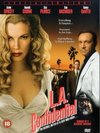
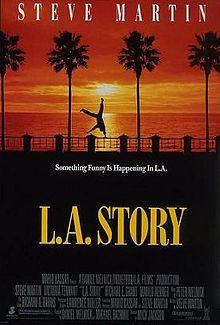






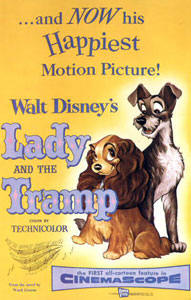
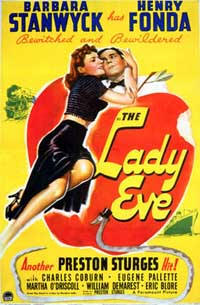
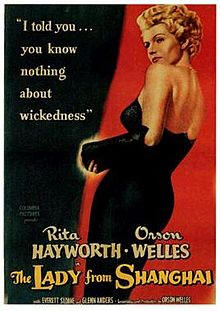
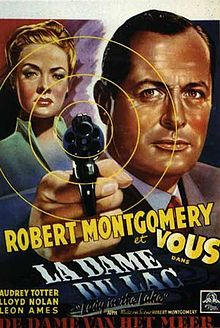
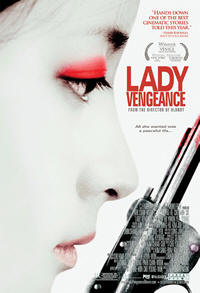





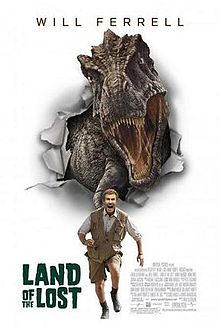
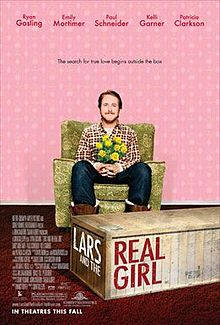
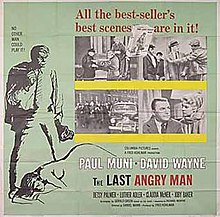
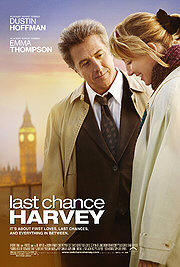


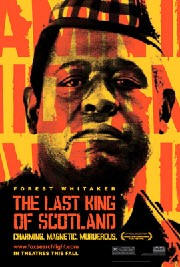
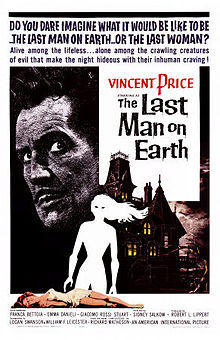
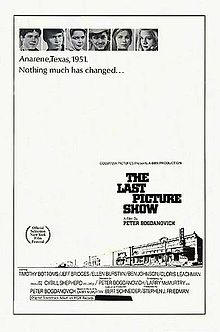


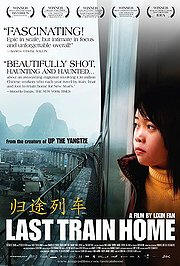

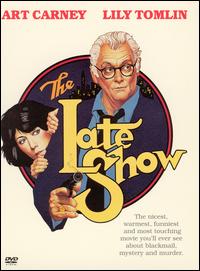

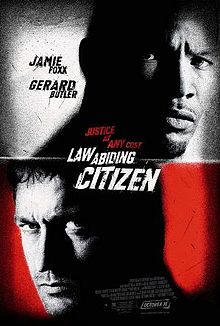

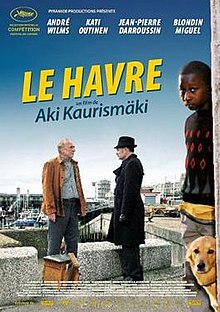
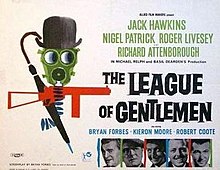
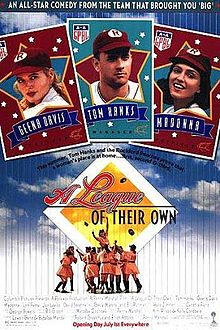
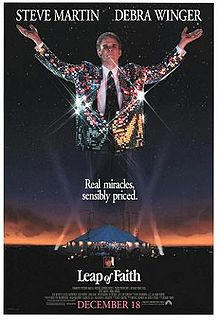

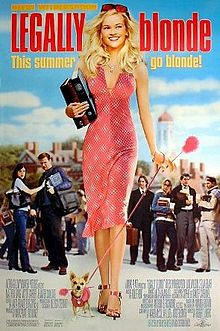









.jpg/215px-Let_the_Right_One_In_(Swedish).jpg)
